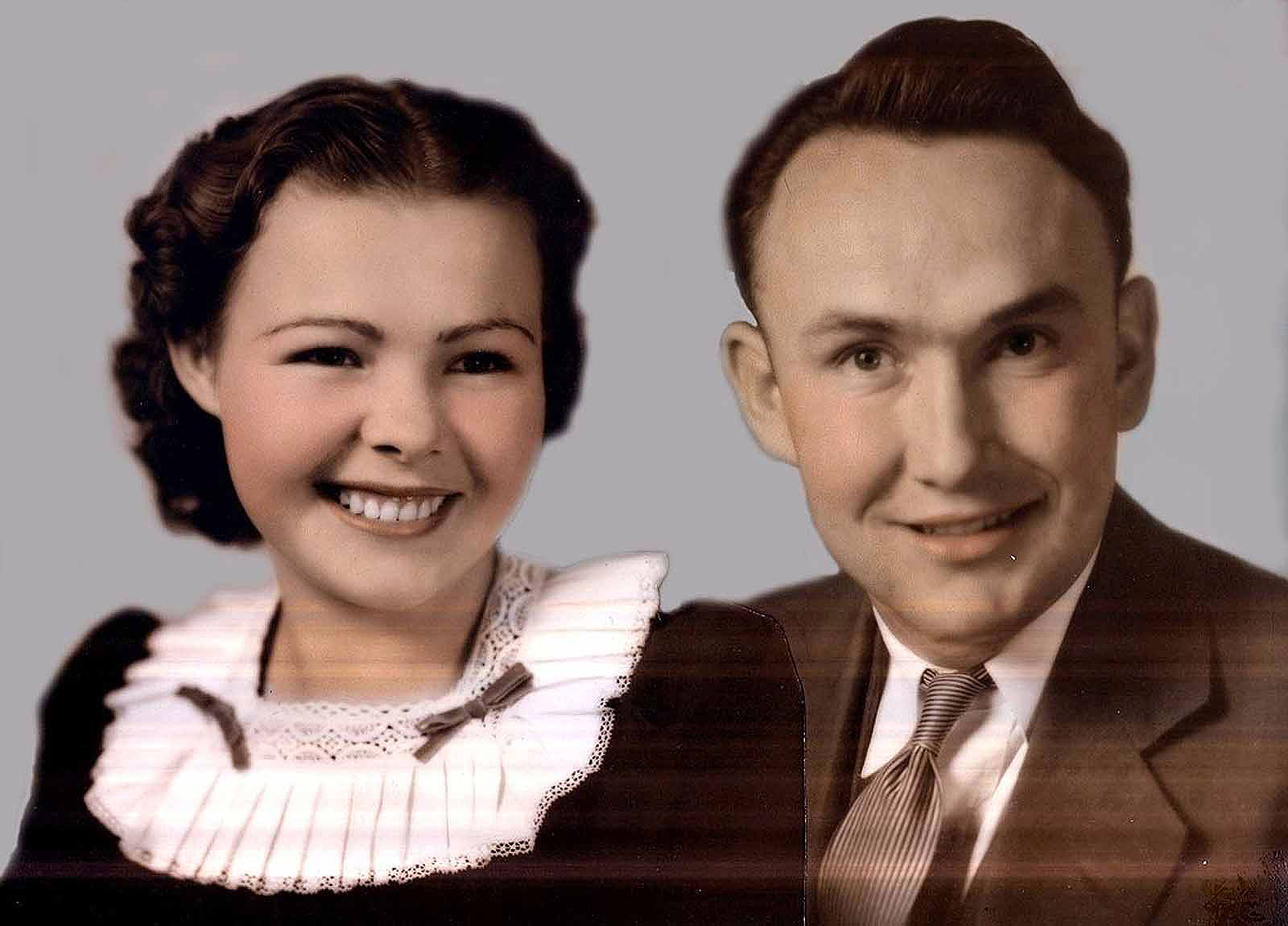 Marie and Rodney Waite just after their marriage.
Marie and Rodney Waite just after their marriage.
My father Rodney Waite was born in Bunkerville, Nevada on January 7, 1919. My mother Marie Iverson was born in St. George, Utah on December 6, 1919. She graduated from the eighth grade in St. George but couldn't afford to go to high school there because Utah charged tuition to high school students. Nevada didn't charge tuition so she went to Bunkerville to live with a family who were friends of her parents to attend high school. She met my father at Virgin Valley High School in Bunkerville. They were married August 3, 1938 in Mom's parents' home in St. George. They were married civilly because the St. George temple was closed for maintenance. They were sealed in the St. George temple on November 9, 1938.
They lived with Dad's parents after their marriage. My father got a job working for a turkey farmer in Logandale, Nevada. They moved to small house on the farm. They worked for the farmer until the turkeys were killed and shipped. The job ended when the work was finished and they moved back to Bunkerville.
In Bunkerville they moved into a small house owned by Dad's brother, Delbert. The house was located on the north side of Diagonal Street, in the southwest section of Bunkerville. Only two rooms were completely finished. Dad found a job working on the construction of a section of Highway 21 near Glendale, Nevada.
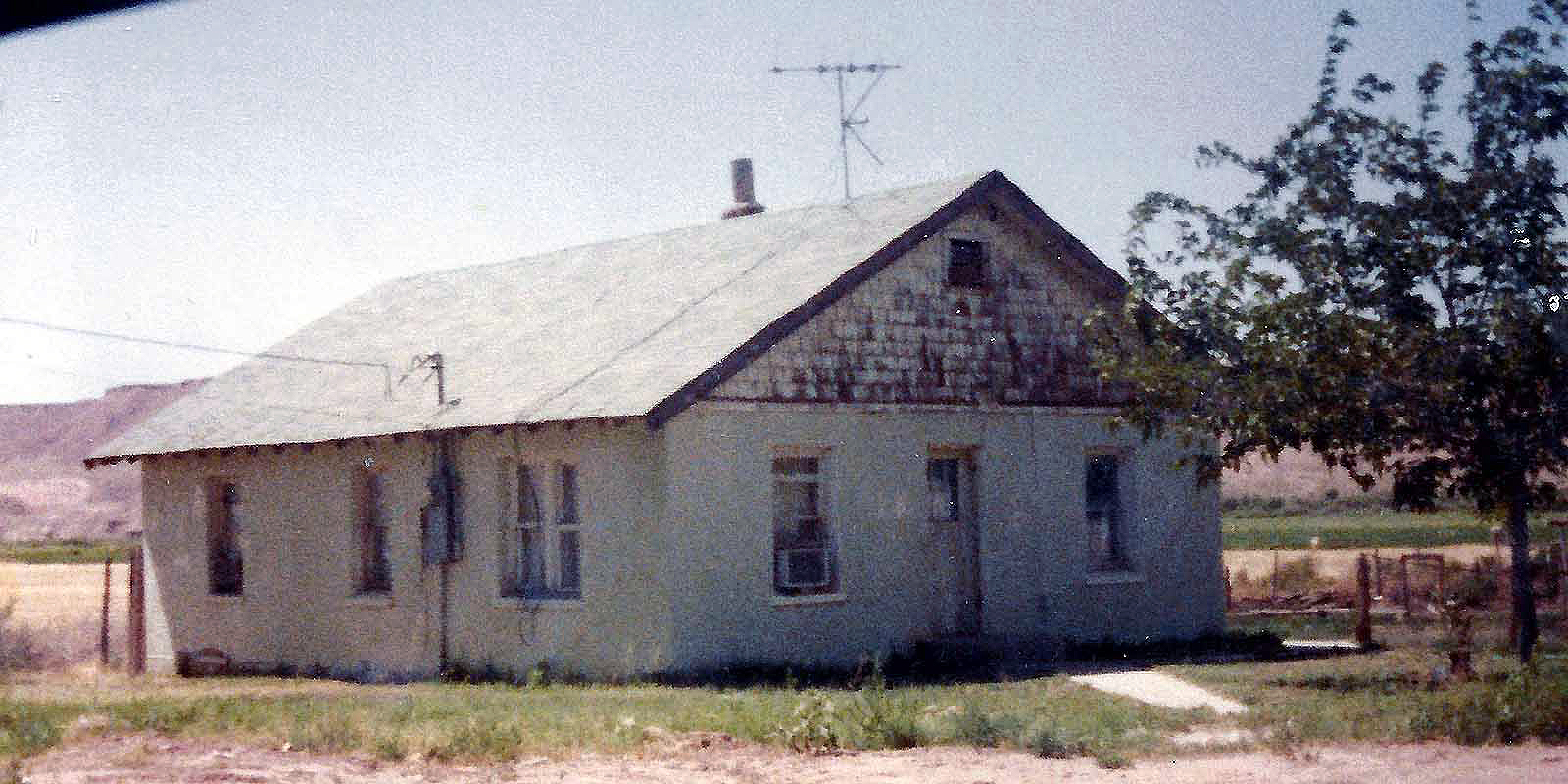 Our home in Bunkerville.
Our home in Bunkerville.
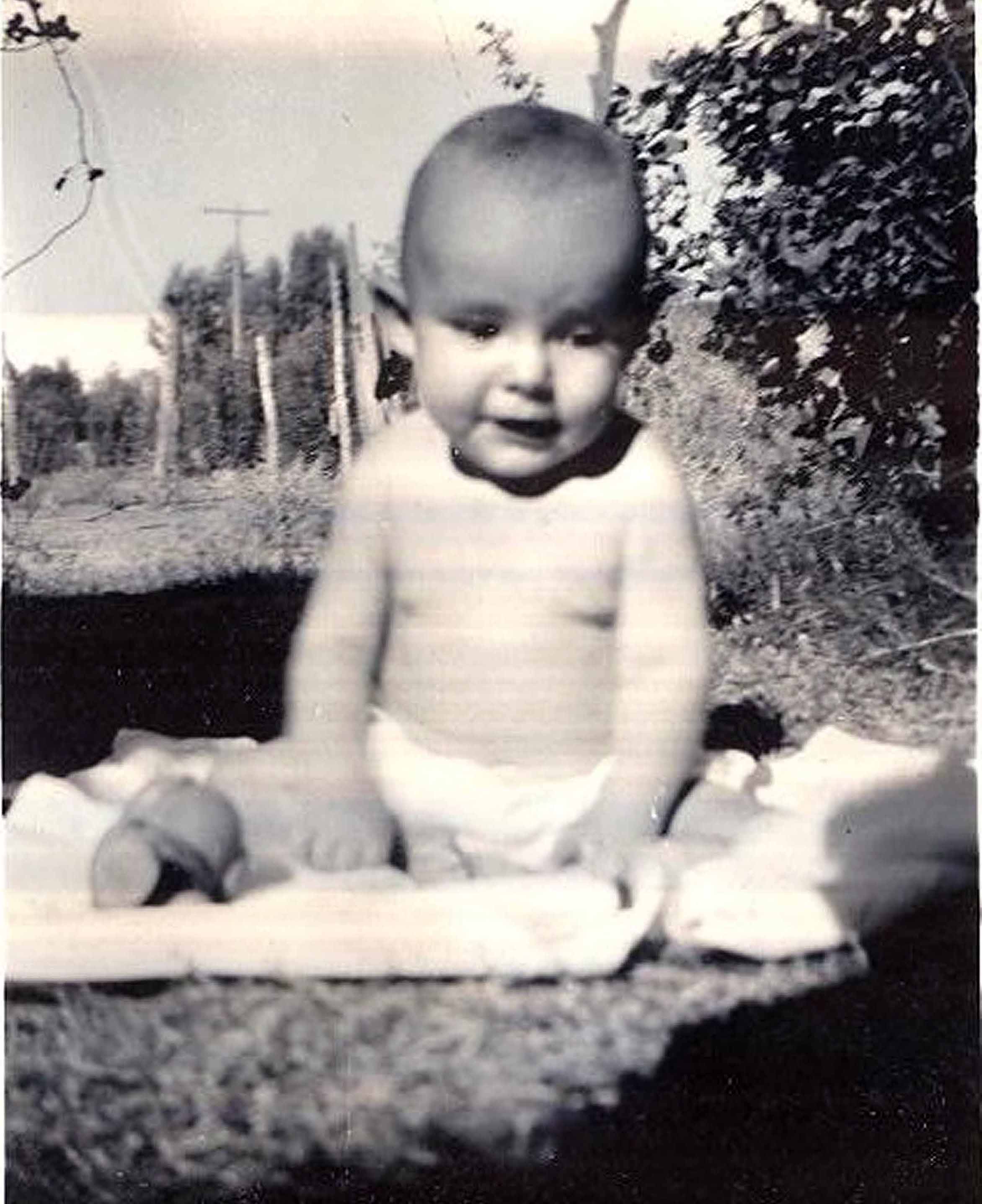 Me in Bunkerville
Me in Bunkerville
My mortal life began in St George. According to my mother she developed high levels of albumin during the third trimester of her pregnancy with me. Her doctor felt that if the albumin increased any more she and her baby would be harmed, so he asked her to stay in St George with her parents, where she could be checked often. Two weeks before I was born he could not hear the baby's heartbeat and he told my mother that her baby was probably dead. She prayed and promised God that if her baby was saved she would do all she could to teach and raise it in the gospel. Finally on 3 December 1939 the doctor insisted that she enter the hospital so he could give her a drug to induce labor. Her labor did not start until he gave her more drugs the next morning. During the labor, while my father was in the room with her, she began to convulse and lost consciousness. My father called for the doctor and I was born at 9:40 am on 4 December 1939 while my mother was struggling to stay conscious. My parents told me many times that they felt it was a miracle that I was born alive and that my mother survived the birth. Some of my siblings have claimed that my mother always treated me better than them. If that is so I attribute it to her relief that I was born alive.
I was named Laron after Laron Knight from Bunkerville a friend of my father's who was killed as a young man. Of course my middle name Rodney came from my father.
We continued to live in Bunkerville even though my father had to go to Las Vegas to find work. He found a job delivering ice in Vegas. He would find a ride to Vegas and work there during the week then go back to Bunkerville on the weekends. While in Vegas he lived with his cousin Margaret and her husband. While he was in Vegas Mom and I would sometimes ride the bus to St. George to see her parents.
During this time my Grandmother Iverson was pregnant with her last child. The child, a daughter, was born on April 11, 1941 in St. George and they named her Sharon Alene.
Mom and Dad wanted to move to Vegas so we would be together. My uncle Leland Waite and his new wife Mary were living in Vegas in a small trailer house. They rented a space for the trailer from a cousin. My parents got permission to put a trailer next to Uncle Lee's. They found a "Truck House" It was a truck with a homemade shell on the truck bed. The shell had only one room. It had a large bed built across one end and cupboards and a cabinet built on the other. They did some repair on it and moved it onto the space next to Uncle Lee and Aunt Mary.
On the night of December 7, 1941 my Uncle Denzel was driving my mother and me from Bunkerville to Vegas. The radio was playing music, suddenly the music was interrupted by an announcement that told of the attack on Pearl Harbor by the Empire of Japan. The announcement was repeated several times. The United States then declared war on Japan. Mom's younger brothers Budd (Alvin), Grant and Keith Iverson joined the Navy. My parents were afraid that my father would also be drafted into the Army.
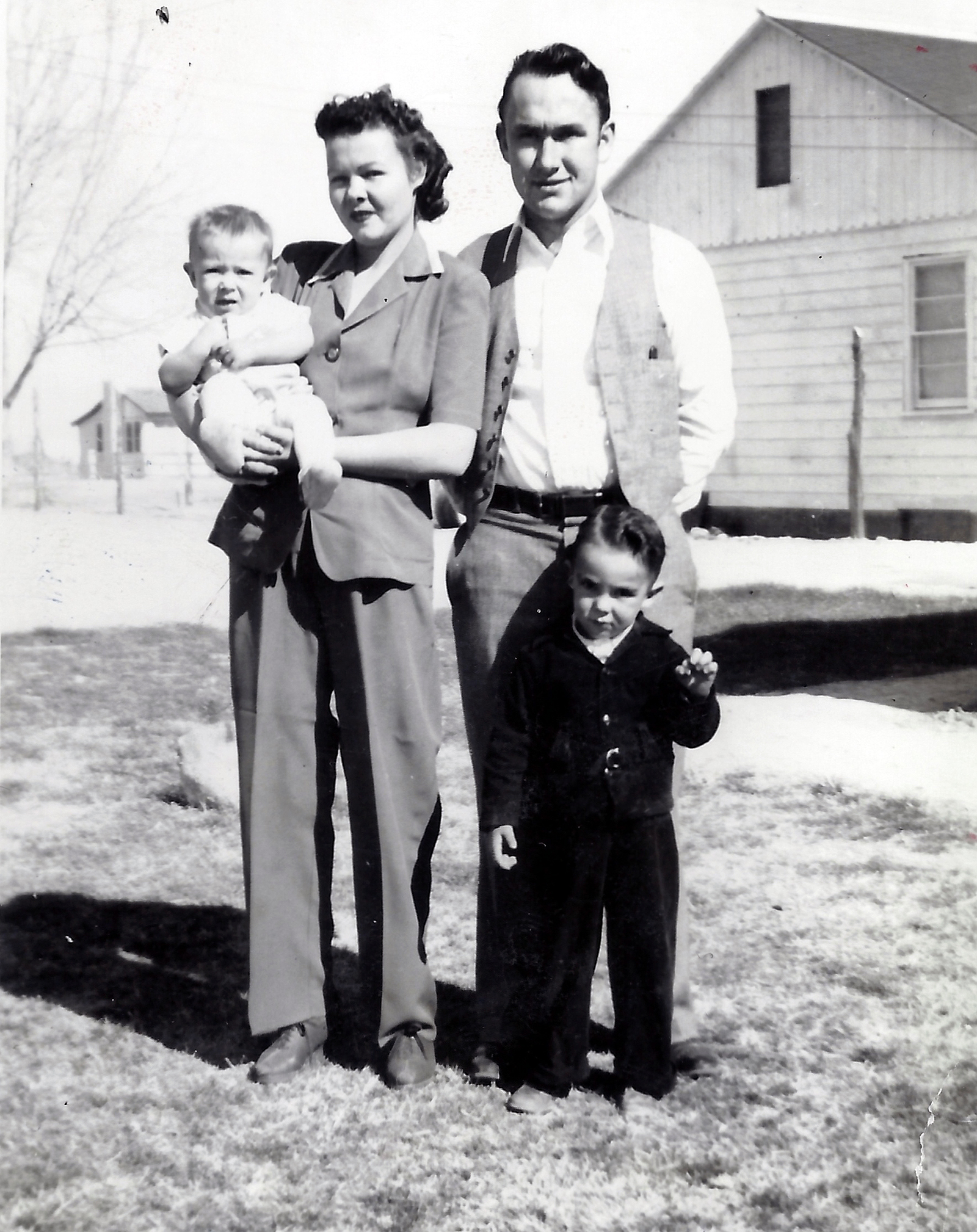 Gary, Mom, Dad and me in front of Uncle Lee's and Aunt Mary's house in Las Vegas
Gary, Mom, Dad and me in front of Uncle Lee's and Aunt Mary's house in Las Vegas
We moved into the truck house a few days before Christmas 1941. My father had joined Uncle Lee working in a plant that produced magnesium for the war effort.
Mom was pregnant with my brother Gary. She had problems with producing too much albumin again. The doctor gave her medication to control it. Gary was born on April 25, 1942.
Uncle Lee's wife Mary had been married before to a man named Merlin Bunker. The marriage ended in divorce. She had a son from the marriage named John.
Uncle Lee and Aunt Mary decided to buy a house in the northwest part of Vegas near Merlin's parents John Bunker and his wife. They bought an old house that needed a lot of repair. Mom and Dad helped them repair and clean it. They moved in and invited Mom and Dad to move our truck house onto their lot. They parked truck next to the house and put up a small white tent at the back. They used the tent as a bedroom.
Mom and Dad decided that they wanted to move away from Vegas. They didn't like the gambling influence they also wanted to find a place with more water and that wasn't so hot. Dad's uncle Frank Leavitt had moved his family to a place called Homedale in Owyhee County, Idaho. They had gone back to Bunkerville and told the people about it.
Mom and Dad thought it sounded good so in the fall of 1942 we went there. They liked the area and decided to move there. They made a second trip there in the spring of 1943 and bought a place with 20 acres of land, a house, a barn and corrals for $4,500.00 from a family whose last name was Nihart. The property was on South 2nd Street East (Highway 95) just south of Homedale near a curve in the road.
They returned to Vegas and made arrangements to move to Idaho. In May of 1943 they paid a man named Harley Adams $100.00 to use his truck and haul their furniture to their new home. The place was well watered with a lot of trees, bushes, flowers and a lawn. There was a small orchard with apricots and nectarines. There was also a patch of raspberries. There was a barn with corrals, a smoke house, an underground cellar, a chicken coop and a garage. The house didn't have a bathroom or any plumbing inside. There was a well with a hand pump. My parent's really liked the place. We kept rabbits, chickens, pigs and cattle on the place. We hand milked the cows, got eggs from the chickens and ate the pigs and rabbits. Dad planted wheat in the largest field.
Dad's brothers Lee and Denzel with their families followed us to Homedale.
 The Nihart place in Homedale
The Nihart place in Homedale
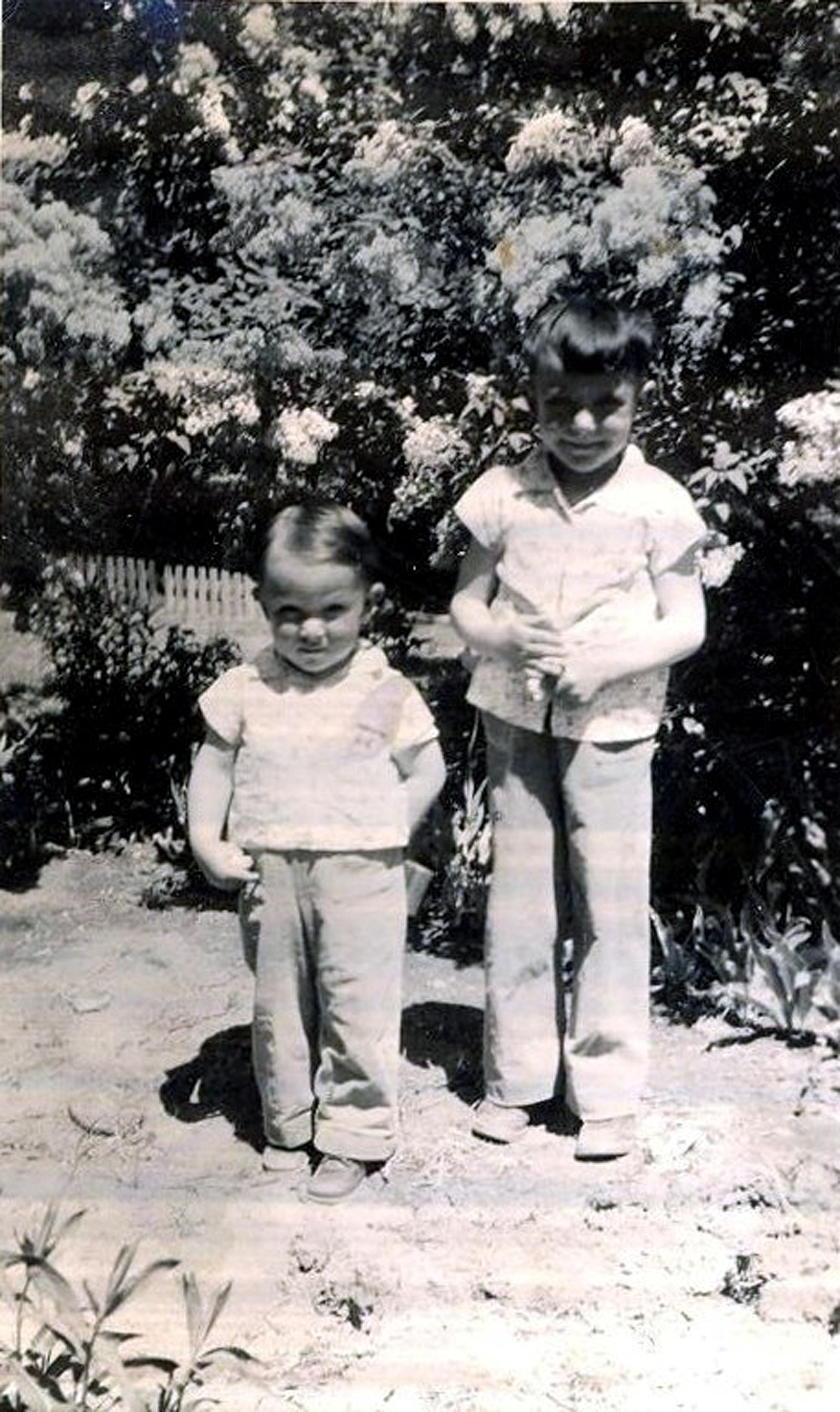 Gary and me in the yard
Gary and me in the yard
Gary and I enjoyed playing in the yard and barnyard. We had two white kittens that we played with. We were rough on the kittens. One was mean to us so we called him Meany. To punish him we drug him through the water in the irrigation ditch. I hope we were chastised for doing it. In her history, my mother mentions many things I did and said while we lived at the Nihart place.
One of our rabbits escaped from its pen and roamed free in the yard. Somehow it fell into the hole below the outhouse. I remember Uncle Keith trying to get it out. I believe he put some grape vines in a bucket and lowered it into the hole hoping the vines would entice the rabbit into the bucket so he could lift it to the surface. I don't remember it he was able to get it up.
My father had a hard time finding a good job at first. His job in Las Vegas had paid well but he had to take low paying, temporary jobs in Homedale. He felt living there was worth the loss of pay. Later he found a job at a produce packing company named The J. C. Palumbo Fruit Company. He was the foreman of the production crew. The company shipped apples and potatoes to markets in the east. Later they also shipped peaches, prunes and onions.
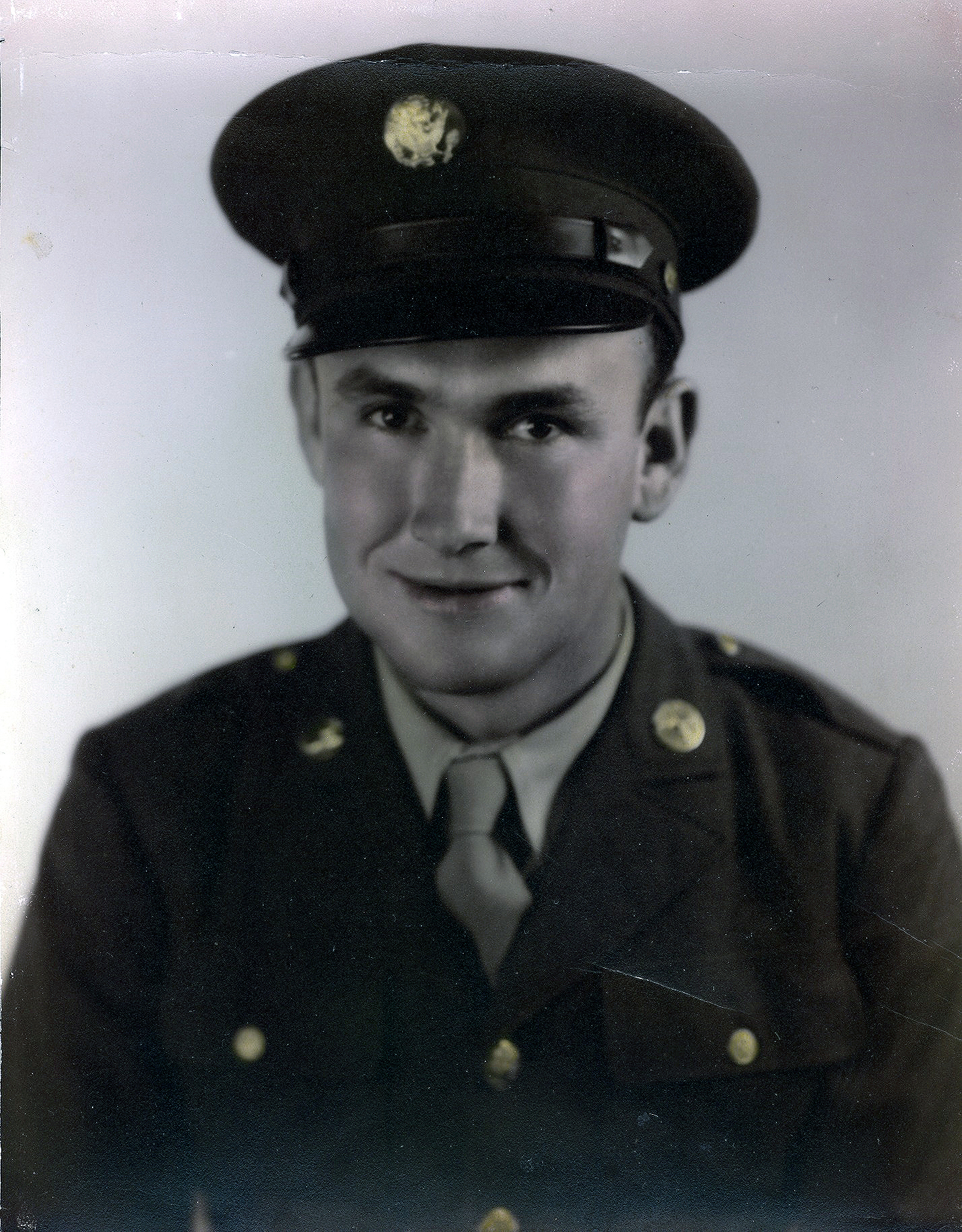 Dad in his Army uniform
Dad in his Army uniform
Homedale had a population of less than 1000 people. It was settled in 1898 when a man named Jacob Mussell built a ferry to take people across the Snake River. By that time there were many ranches in Owyhee County. Some of the ranchers were Basque people from Portugal who raised sheep. In 1914 eight families from Austria with the surnames of Demshar, Dolence, Cegnar, Kushlan, Bahem, Jesenko, Marchek and Miklovich arrived. They had been lured to the area by people who sold them land south of Homedale. When they got there they learned that the government, not the speculators owned the land. They found that it was good for farming so each family stayed and bought the land again. Many of their descendants are still there. About the same time some Japanese people from the west coast arrived and bought farms. Later, when the farms were well developed and needed laborers to help in the fields, people from Mexico came each summer. Some of them became permanent residents. When we got there in 1943 the Basque, Austrian, Japanese and Mexican cultures were a large part of the fabric of Owyhee County.
In 1944 Dad was drafted into the Army. He was inducted October 25, 1944 and sent to Camp Walters in Texas. He had hurt one of his knees when he was young and it hurt him when he marched so he was transferred to the Army Air Core unit where he served as a quartermaster.
My mother was pregnant with her third child when Dad was drafted. She didn't want to face taking care of the farm by herself so she sold it. Her father, Victor Iverson rode a bus to Homedale, then drove us to St. George in our Studebaker car. We planned to live with Mom's parents while she waited for the baby to be born. While we were there I spent many hours playing with my Uncle Archie's marbles
Mom was restless, worried about Dad and had a hard time getting along with Grandpa Iverson so she rented a small white house in Bunkerville. I have one memory of watching my Grandpa Waite sitting in a chair in his house. I was afraid of him. He twisted his face and make loud noises scare me. My grandmother swore at him and told him to quit.
While we were in Bunkerville the time arrived for the birth of Mom's child. She went to her parent's place in St. George and left Gary and Me with Grandpa and Grandma Waite. Her third son was born in the hospital on February 23, 1945. She named him Richard Lee.
The war had a disastrous effect on my mother's family. Her brothers Alvin (Bud), Grant and Keith all joined the Navy and were sent to the Pacific Ocean theater. Her cousin, Arthur Cromwell, was in the Army and was killed in Germany in September 1944. His older brother Robert Cromwell was also in the Army and was killed in Luzon, Philippines on 22 June 1945. Another cousin, George Iverson was a Marine and was killed 25 February 1945 on a Japanese island called Iwo Jima. My mother was very fearful that my father would also be killed. However, he remained in the United States and was discharged in December 1945 after the war was over. Throughout the rest of her life Mom resented the people of Japan and referred to them as those dam Japs
. She never felt that way about the Japanese American friends we had in Homedale.
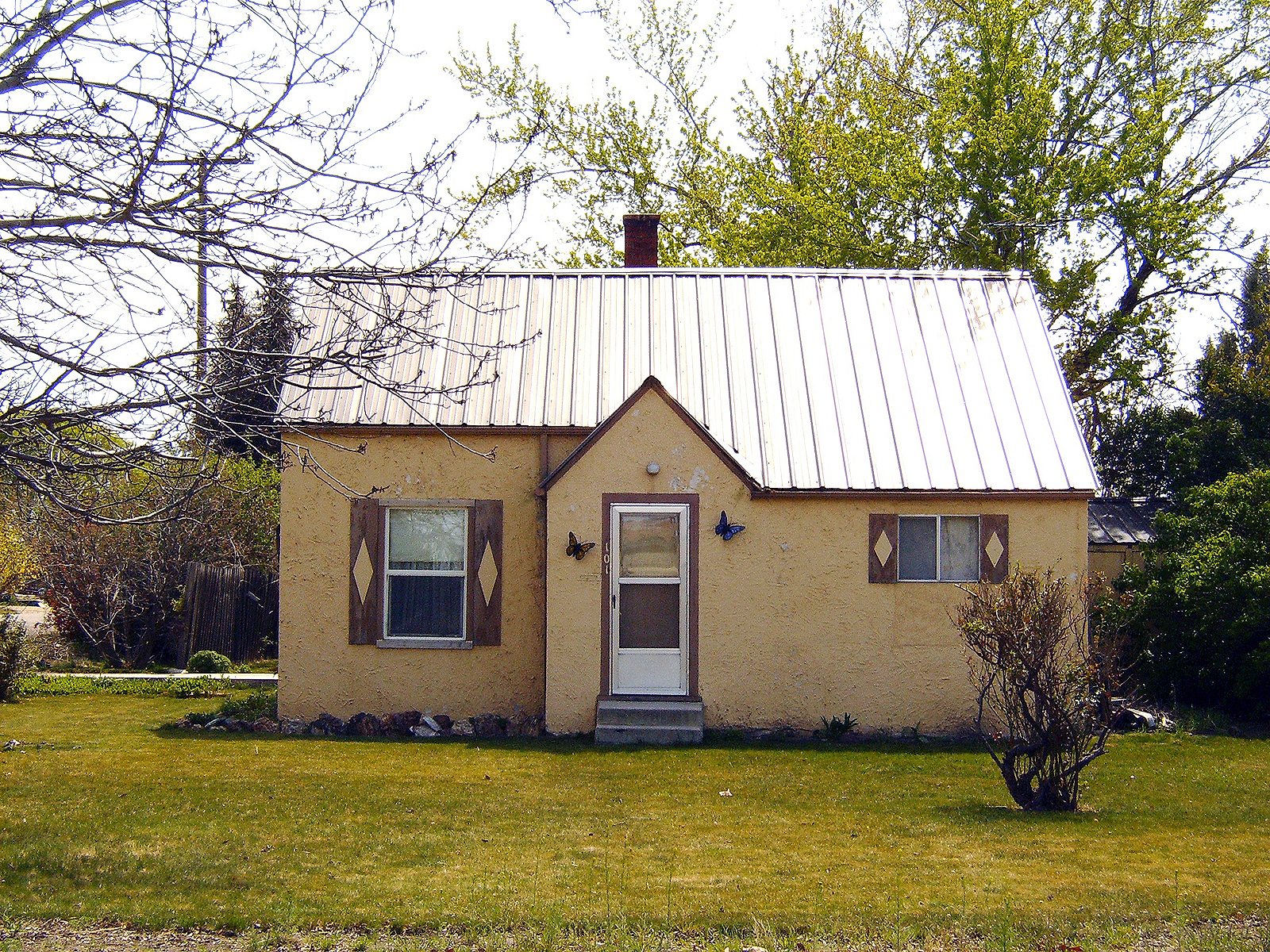 Our home at 101 West Oregon Avenue when we moved back to Homedale.
Our home at 101 West Oregon Avenue when we moved back to Homedale.
We planned to move back to Homedale when Dad was discharged from the service. Uncle Lee and his wife, Mary invited us to live with them. In May of 1945 Dad's brother Dan and his wife Fern drove us to their place. We lived with Uncle Lee and Aunt Mary until Mom was able to rent a small white house in town on 101 West Oregon Avenue from some people called Taylor. An older woman called Mrs. Rainy lived across the street to the north, she was friendly and helped us move in.
While we waited for Dad to return a part in our car's engine broke. Because of the war we could not get a new part. We had to walk everywhere that we needed to go. Mom would push Richard in a baby buggy and Gary and I would walk. Winter arrived before Dad and we got very cold as we walked.
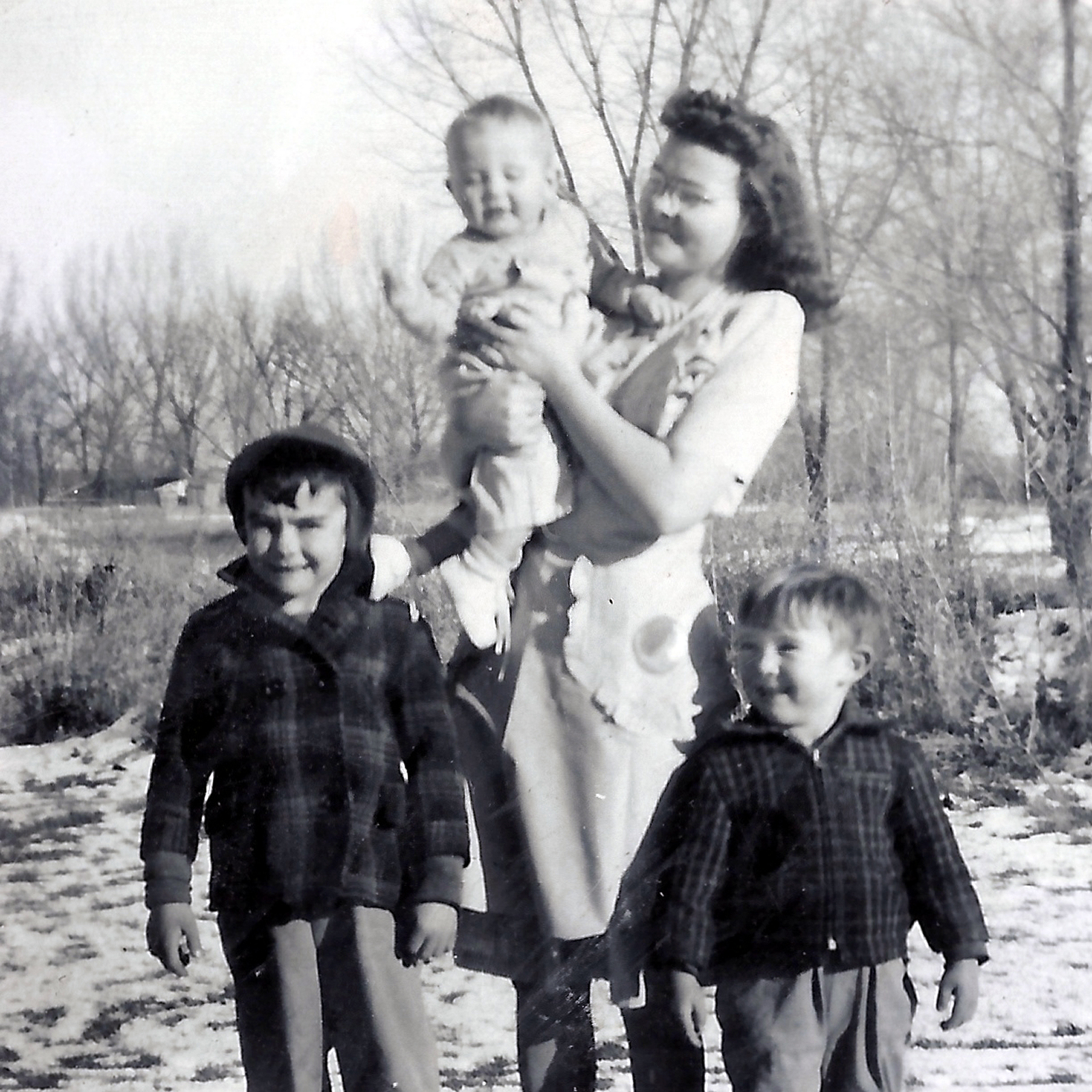 Me, Richard, Mom and Gary in front of the Taylor place.
Me, Richard, Mom and Gary in front of the Taylor place.
Dad was discharged December 15, 1945. He stopped in Detroit and bought the part we needed for the car. He traveled by train and arrived in Caldwell, a town about 15 miles east of Homedale, in the middle of the night. We didn't know when he got there and we didn't have a telephone so he couldn't call us. He couIdn't find a taxi or anyone to bring him on to Homedale, so he walked in the frost and cold carrying his suitcase and that heavy car part. It began to snow and the walking really got slick. He finally got a ride with someone just before he got to Homedale. We didn't have a phone so he couldn't call.
The family that lived just west of us were very poor. They wore torn and dirty clothes, their hair was long and shaggy and they very seldom took baths. Dad had learned to cut hair so he offered the cut their hair if they would take a bath and wash their hair. They were glad to accept so they became much cleaner when they needed a hair cut.
My Grandfather Victor Iverson died January 3, 1946. While he was at work in a gem shop in St. George he began to feel ill. He left work early in the afternoon to walk home. He couldn't walk so some one took him home. He died of shortly after getting home.
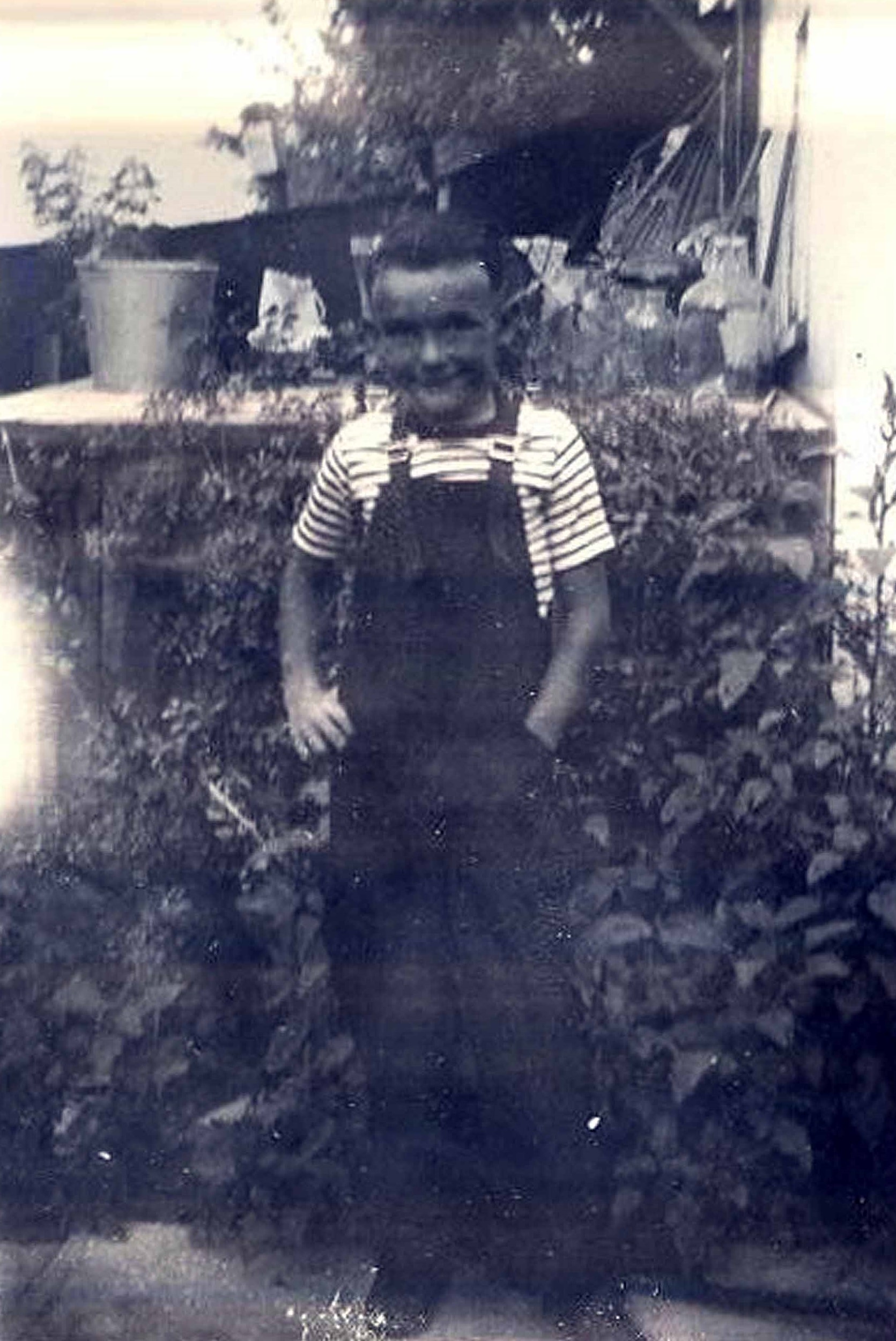 My first day of school
My first day of school
We went to St. George for the funeral. The roads in Idaho were snow covered and the driving was hazardous. We had a hard time going up King Hill. Many cars were stuck in the snow. A bus carrying servicemen was stuck. The soldiers got out and helped the rest of us get up the hill. Then they and the other men pushed the bus up.
I started school at Homedale Elementary in the fall of 1946. I remember posing for a picture on the east side of the house just before I left for my first day of school. The school was three blocks west of our house. It was housed in a very old, large square, brick building that appeared to be in a permanent vandalized state. There were also three or four newer wooden buildings each of which housed a class. Across the street to the west was the junior high school. About three weeks after school started I became ill and had to stay home for 17 days. I remember vomiting tomatoes on my desk and the teacher frantically moving all of the other students out of the room.
Shortly after I was born our family doctor found that I had a heart murmur. For years each time a doctor examined me he could hear it and would tell my parents that I needed to be careful, not become fatigued and not participate in sports. Finally when I was in the eighth grade I was told that the murmur was gone.
My parents, Uncle Moroni (Mac) Waite, and his wife June bought some land about two miles south of Homedale on Highway 95. They divided the land with my parents taking the largest piece. We built a basement house on our land and Uncle Mac and Aunt June built a small house on theirs. Each family also built a barn and corrals to keep cows in. We moved into the basement on November 7, 1946.
We had a small hay field next to the highway. To get to our house we had to travel up a graveled road that ran east and west on the north side of the field. The road was between the field and a drain ditch. A labor camp was on the other side of the drain ditch. The road crossed the drain ditch where it ran north and south. Uncle Mac's barn and corrals were next to the road where it crossed the drain ditch.
The road continued around our house and up a small hill where it turned south. The Watterson family lived on the road after it turned south. They had two boys named Billy and Freddy and two girls. We spent a lot of time playing with them.

A drain ditch ran along the north and east part of our property. We pumped water from the ditch to irrigate our fields. Each time we started the pump we had to prime it by pouring water into it. One morning after I had primed the pump I climbed out of the ditch to change the water in the hay field. We had a barbed wire fence at the top of the ditch bank. I couldn't see the wire because the sun was shining in my eyes and I ran into to it. A barb on the wire cut my right eyebrow. I still have the scar from the cut.
My brothers and I had a small, red Radio Flyer wagon that we liked to ride in. I was riding in it down the drain ditch bank toward a culvert. I lost control and went into the ditch. It was deep enough that I went completely under water and spent some moments frantically trying to reach the surface. That scared my brothers and me and made my mother angry so I was more careful after that.
One ditch ran between our place and the labor camp. The banks were quite high because the dirt from the ditch was piled there. Many times we climbed the bank on our side and looked over into the labor camp. Sometimes all of the people in the camp were men who had come from Mexico to work on the farms. Sometimes they brought their families with them. We played with the kids from the camp and sometimes we had altercations with them. Some of the disagreements resulted in rock fights where we would hurl stones at each other over the ditch banks.
I played marbles a lot while in elementary school. We would make a circle in the dirt then each of those who wanted to play would put the same number of marbles inside it. We would shoot a marble at the ones inside the circle. Each player would keep the marbles he knocked outside the circle and he would keep shooting until he missed. There was a great advantage to shoot first. We would "lag" to determine the shooting order. To lag we drew a line in the dirt then each person playing would roll their marble toward the line. The one whose marble was closest would go first and so on to the last.
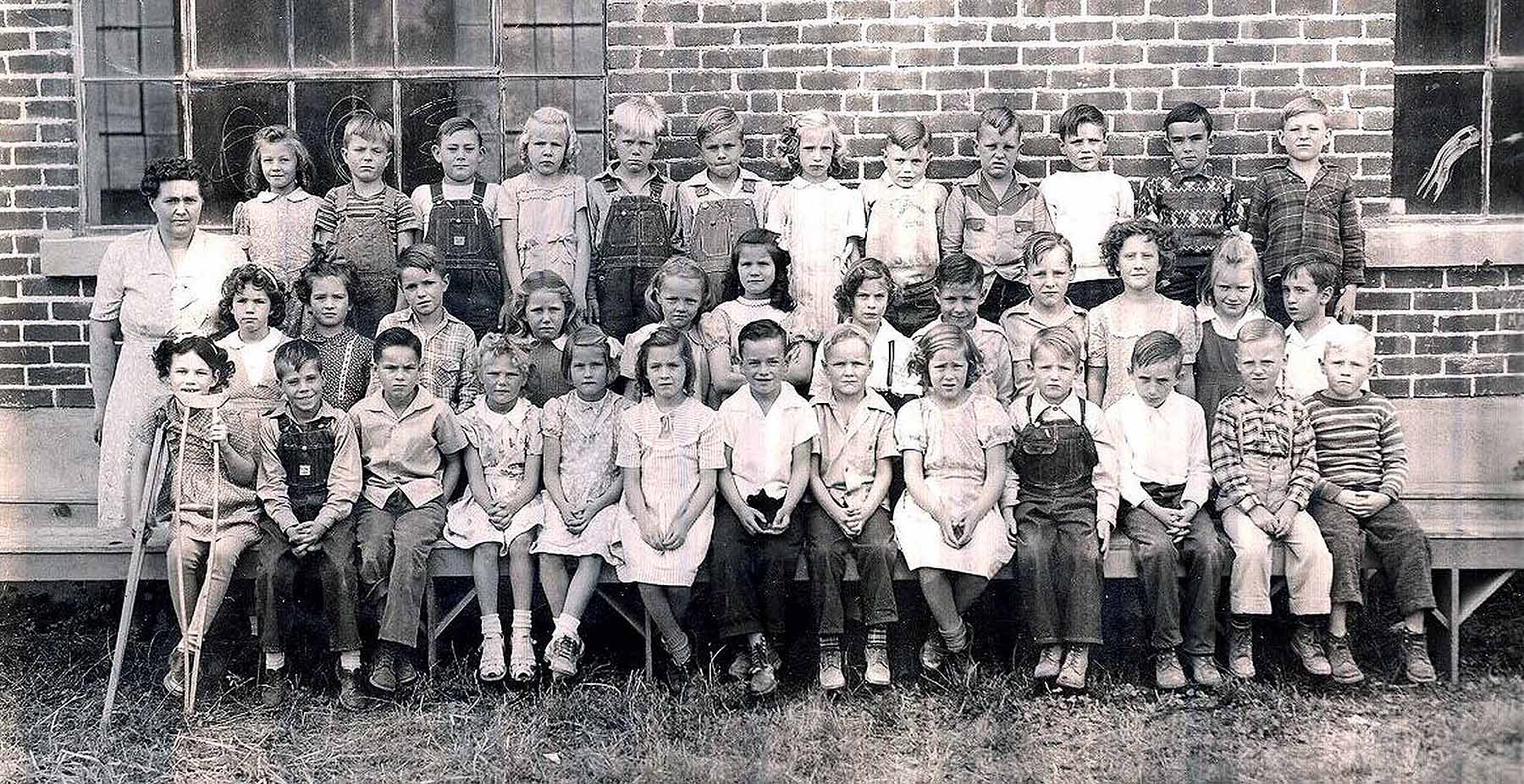 My second grade class. I am standing between two of my cousins on the right side of the back row. The teacher is Mrs. Chrichton.
My second grade class. I am standing between two of my cousins on the right side of the back row. The teacher is Mrs. Chrichton.
My Grandfather Waite died July 9, 1948. My mother was pregnant with her forth child then so my father was the only family member who went to the funeral. He traveled to Bunkerville with his brother, Uncle Lee. My sister Pat was born December 15, 1948. My mother thought she was the best thing in the house.
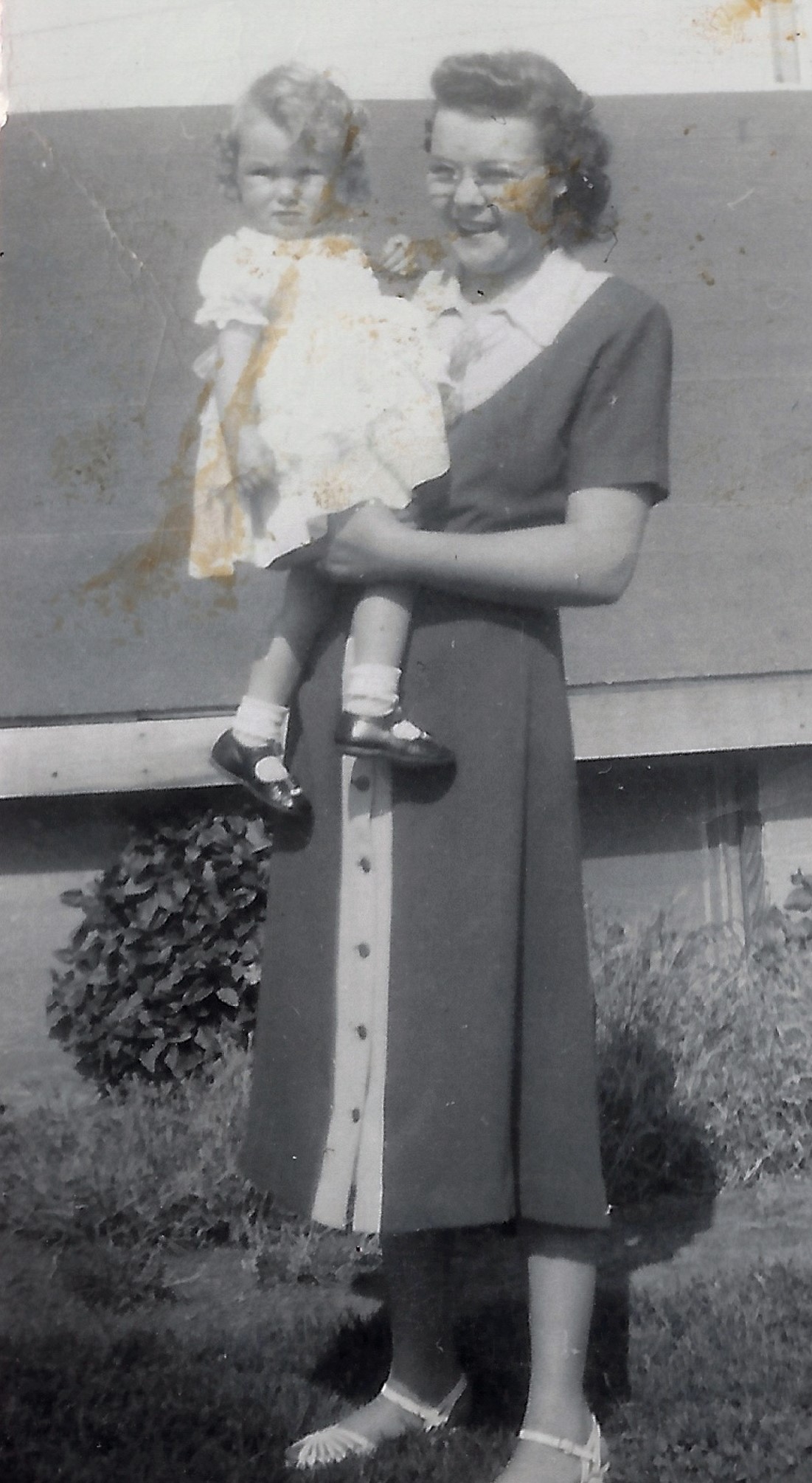 Pat and Mom in front of the basement house
Pat and Mom in front of the basement house
I got my first horse while living in the basement. His name was Prince and he was a three year old bay. One day I rode him on the highway and he became frightened. He jumped so much that I fell off and hurt my arm. I was never able to control him after that, so my father sold him.
I bought another horse when I was 13. It was a strawberry roan mustang mare named Gypsy. She had a long broom tail and was very bossy. She was raised on the McKenzie ranch in the Owyhee Mountains south of Homedale. We used her to ride mountain trails. She felt that she always had to be first when we were trail riding or hunting.
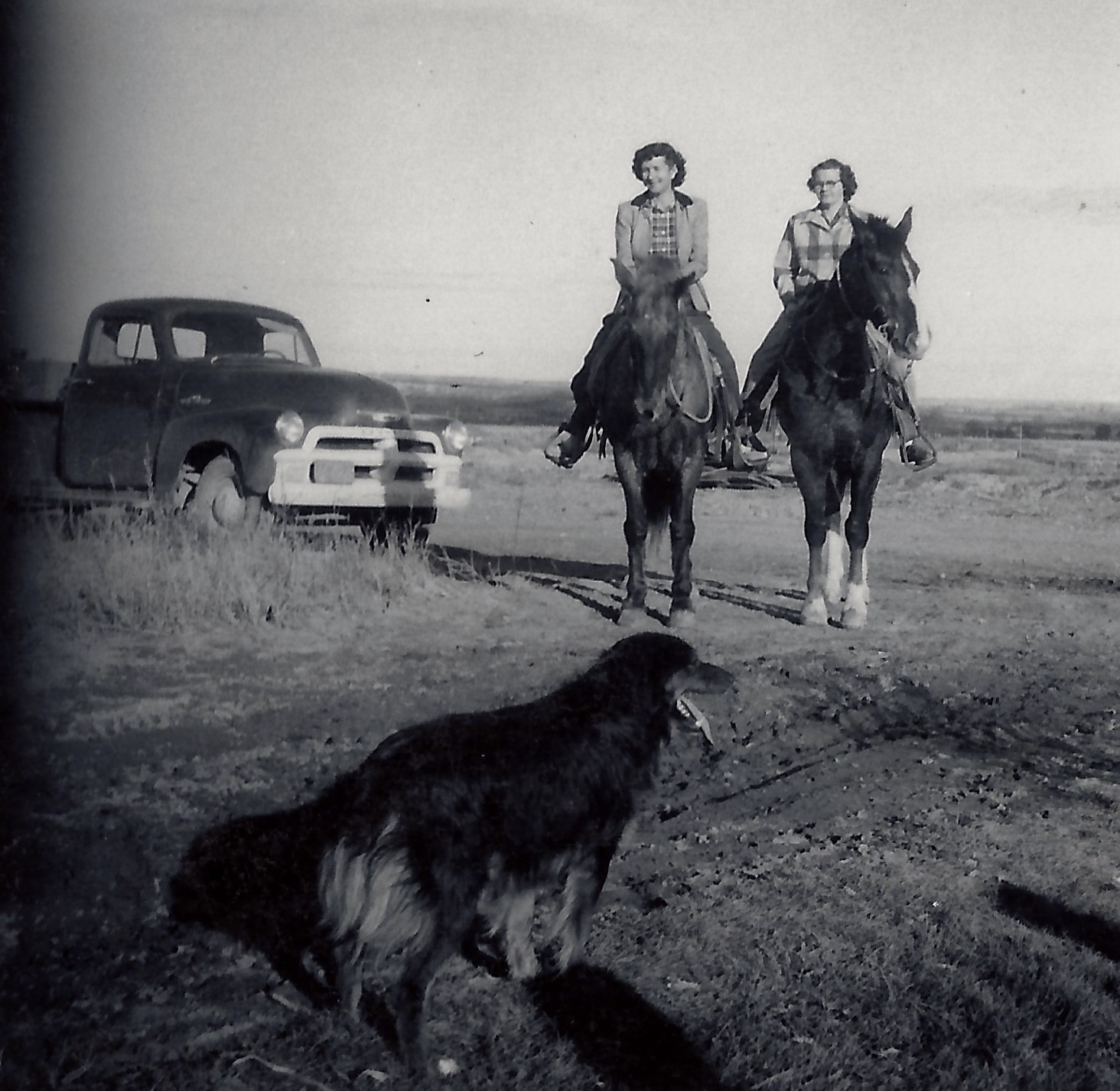 Aunt Iona on Gypsy and Mom on Nipper in our driveway
Aunt Iona on Gypsy and Mom on Nipper in our driveway
I bought another mare called Babe, two saddles and a bridle. My father bought a well built bay gelding called Nipper and gave him to Gary. I traded Babe and a saddle to Gary for Nipper. I rode him more than I did Gypsy. More than once my brother, Gary and I rode Gypsy and Nipper into the hills south of our place to camp. We thought we were almost mountain men.
East of the highway was a sheep camp owned by Johnny Quintana. It consisted of large pens for the sheep, a ram-shackled cook house and a bunk house. I worked there a few times helping with the sheep. During the summer the camp was deserted because the sheep had been taken to the mountain pastures. Gary and I liked to ride our horses through the camp, chasing each other between the pens and the buildings. Once he ran into a wire that was stretched across a lane. It hit the top of his head and knocked him from his horse.
My cousin Eldon Leavitt lived on the farm just west of us. There were a lot of boys in their family so my brothers and I spent a lot of time there. Later in high school Eldon and I worked for my father. We spent much of our free time with another cousin, Byron Leavitt, exploring the sagebrush desert south of Homedale.
We usually had two or three milk cows. We had to milk them by hand. I spent a lot of time each day in the barn cursing cows. We sold most of the milk. We shipped the milk to the processing plant in 10 gallon cans. Each morning the milk man would take the full cans and leave the empty ones from the previous day. If we didn't keep the milk clean or if it spoiled they would dye it pink and return it.
We also raised chickens, rabbits and steers for meat. We kept the rabbits in a "hutch", a small shed with layers of cages along the sides. Each cage had a wire bottom to let the refuse fall through and below the cage was a metal sheet that could be removed to empty the trash.
Cleaning the rabbits pens was bad but nothing was as distasteful as cleaning the chicken coop. The smell was terrible, the floor filthy and feathers were there to be breathed. The chickens were never very happy about it either, especially the roosters who didn't want us to invade their domain.
We had a yard light on a high pole near the barn and another one near the house. The path from the house to the barn went through the garden and was long enough that neither light shone on the garden area. After I finished my outdoor chores in the night I would run from the barn to the house. I must admit that sometimes my imagination created wild bulls along the path among the bushes and I had a hard time turning to face the bull and opening the door to the house at the same time.
My father loved to raise vegetables and fruits. We had a berry patch with blackberries, raspberries and strawberries, some fruits trees and a large garden. We irrigated with water we pumped from the drain ditch by running the water down furrows between the plants.
There weren't many members of the church in Homedale. Our ward was very small. When we arrived first arrived we met in an old white building with one large room, a small stage and two small rooms in the back. I spent a lot of time in that building while I was in Primary. We had Primary after school. I remember going through each of the classes there. I gave my first talk there.
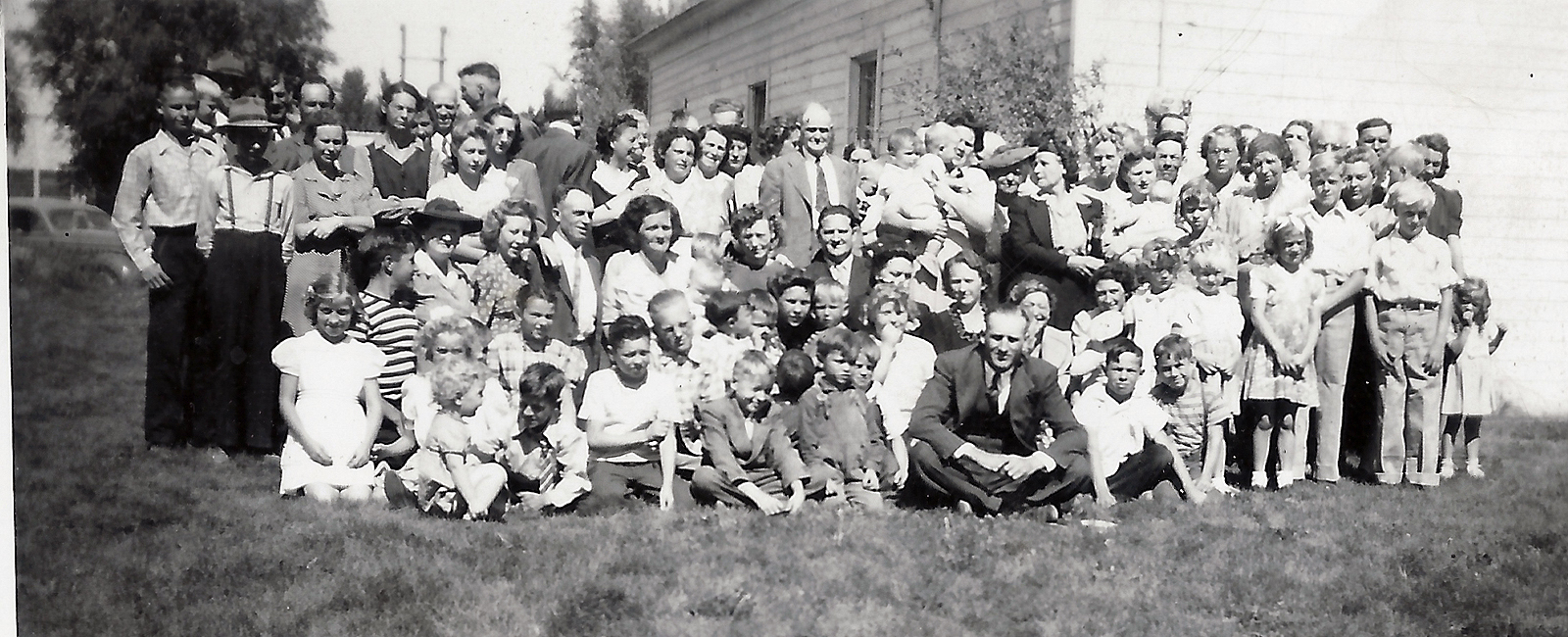 Members of the Homedale Ward in front of the white church building
Members of the Homedale Ward in front of the white church building
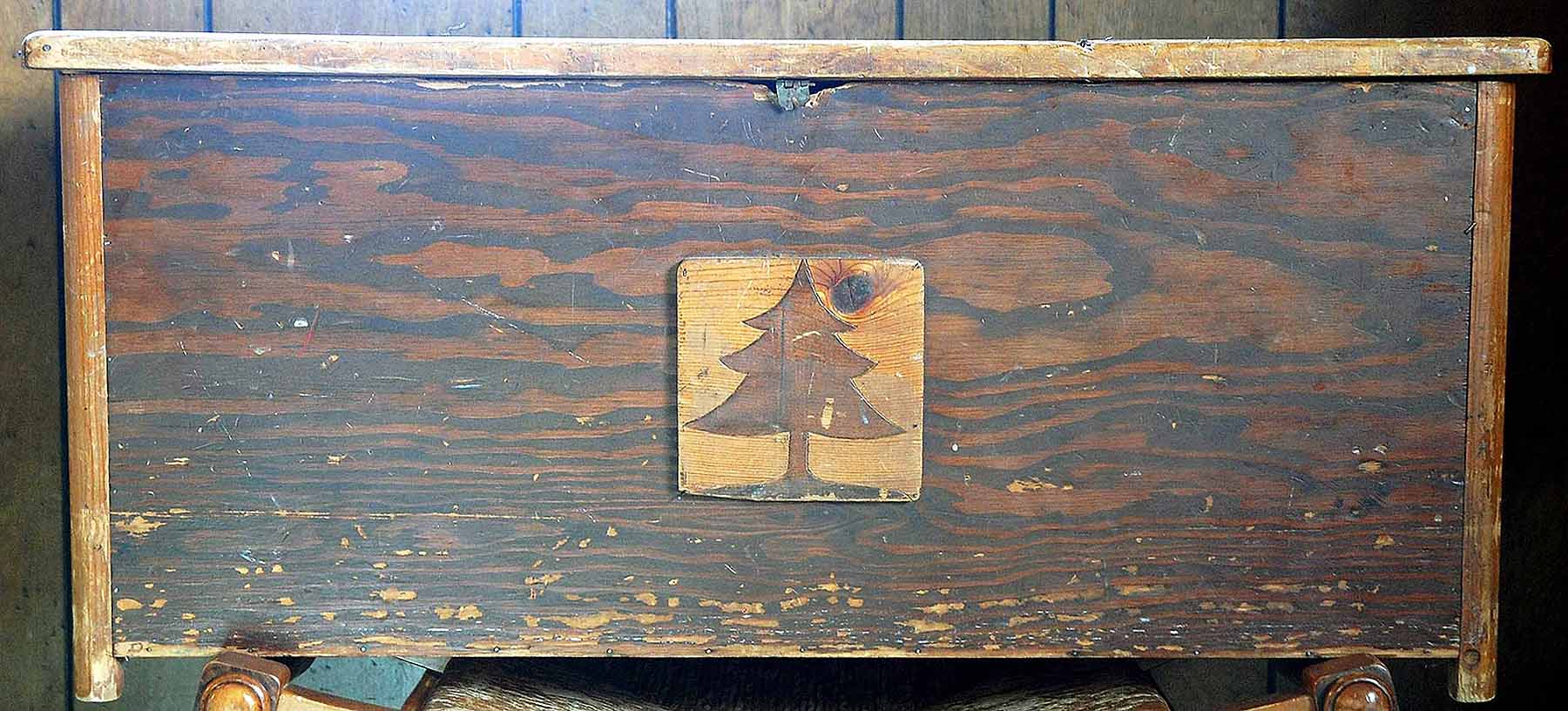
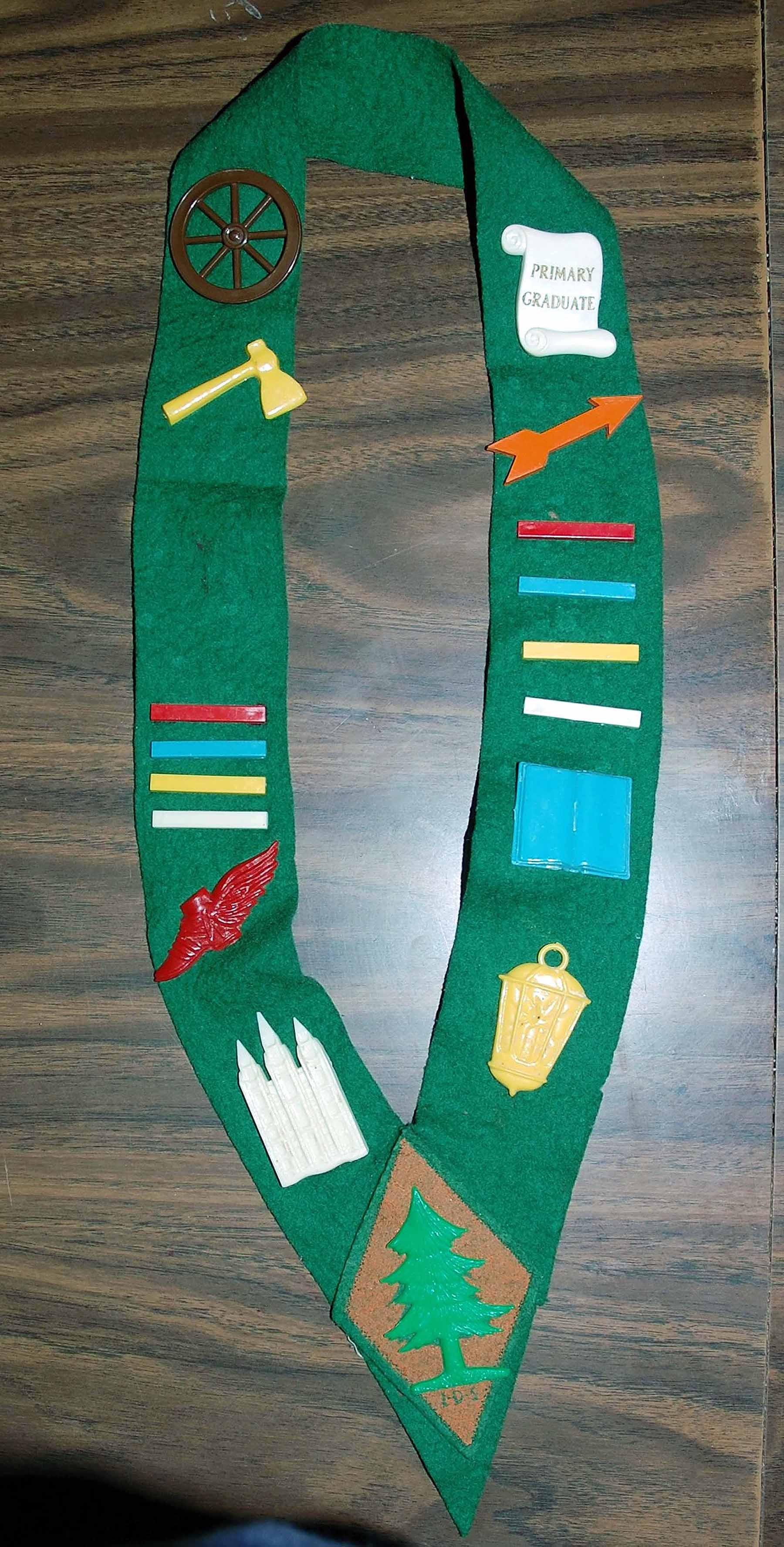
As we progressed through Primary we received emblems to show that we had accomplished certain tasks. The emblems were pinned to a bandelo that we wore to primary functions.
When I was a Blazer Sister Frank, our teacher, helped each of us make a treasure chest just before we graduated from Primary. Her husband who was a carpenter cut out the wood for us and she helped us put it together and decorate it. I still have mine.
In the spring of 1955 while I was in the ninth grade we bought a farm on the north side of the river in an area called Fargo. We sold the basement house to Uncle Denzel and Aunt Iona. Our farm house required a lot of repair. My mother worked long and hard to make it as nice as possible, but it always looked somewhat shabby. I always felt a little ashamed of it when my friends came to visit me.
The place had a large yard where my mother planted flowers. There were also a large barn, a granary, corrals and an old unused silo. We raised calves to sell and for meat and had one milk cow for our personal use. We also kept chickens and ducks. Some of the chickens were Banties, a small feisty breed. The Banties roamed free so they could feed on insects in the garden. The ducks spent a lot of time in the canal that went along the west side of the house. We had two tractors, a small four wheeled Ford and a John Deere that we used to work the fields.
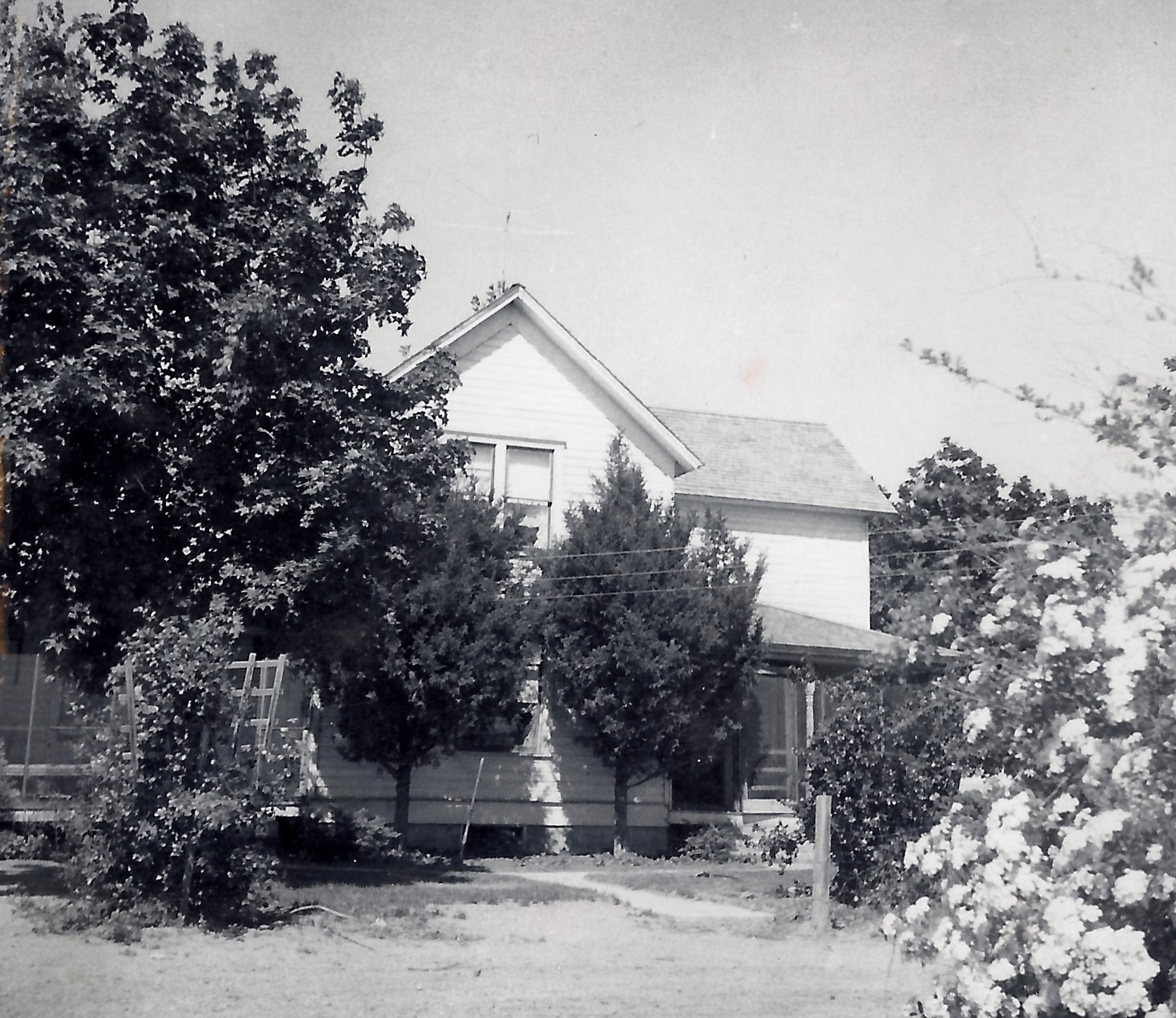 The farm house and front yard shortly after we moved in
The farm house and front yard shortly after we moved in
We had two prune orchards on the farm. We used the Ford tractor in the orchards so we could maneuver between the trees. Sometimes we had to use smudge pots (very environmentally friendly) in the early spring to keep the prune blossoms from freezing. We would spray insecticide (also environmentally friendly especially the DDT) on the trees in the spring. Some of the insecticide was powder and some liquid. We usually sprayed at night when there wasn't much wind. I am amazed that none of us became very ill with the spray that got on us.
We mowed the grass and weeds between the rows of trees four or five times in the summer. In September we harvested the prunes. A picking crew, usually men from Mexico came each year. Some of them came year after year. When the men filled their bags with prunes they dumped them in a box built especially for transporting fruit from the orchard to the packing shed. We removed the stock racks from our truck and used it to pick up the boxes and haul them to the shed.
We also had three fields that we rotated hay, potatoes and corn in. Each year I was involved in preparing the fields, planting, irrigating and harvesting the crops.
When we bought the farm there was a good market for prunes, but within two years we had a hard time selling them. My parents removed the orchards in 1961 and planted the fields in hay.
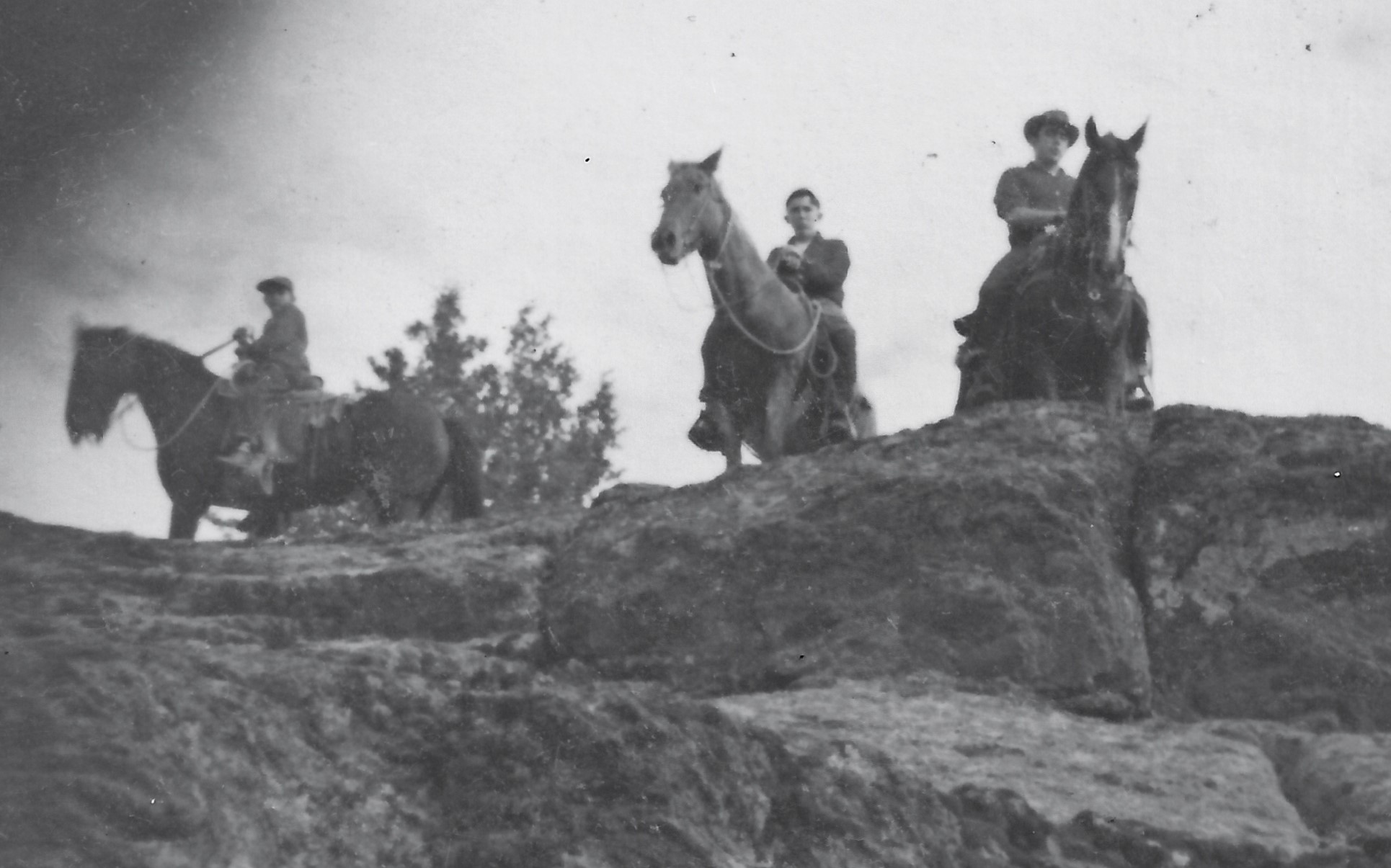 Rick on Gypsy, Gary on Babe and me on Nipper while hunting in the Owyhee Mountains
Rick on Gypsy, Gary on Babe and me on Nipper while hunting in the Owyhee Mountains
My parents were hunters. They hunted for the meat. Much of the meat we ate was venison. They would make some of it into jerky and pepperoni. I went with them on the hunt before I was old enough to have a hunting license. I got my first hunting license when I was twelve and hunted every year after that until I left for my mission. We always took our horses and were able to hunt a large area. We used the same camp and saw the same hunters each year. The hunting was very good. We usually hunted deer in the Owyhee Mountains south of where we lived.
We liked to fish. In the spring we fished Flint Creek, Jordan Creek and Cow Creek in the Owyhee Mountains. In the summer when the water was low enough we went north of Boise to places like Payette Lakes, Lost Lake, Goose Lake, Rabbit Creek and the Payette River.
Nellie Radenbaugh was one of my favorite teachers in high school. She taught language arts. In my very small school that meant she could teach anything from English to History to Economics. I liked her because of her wit and ability to tell stories. She was very old and was probably past retirement age. She and a friend toured England during the summer of 1955 and sent this postcard to me.

I bought a boat with a 50 horsepower motor on it. We used it to fish the reservoirs and lakes. Deer Flat (Lake Lowell) near Caldwell was our favorite place to catch catfish. We also liked to troll for trout on the Duck Valley Indian Reservation and Deadwood Reservoir.
 My car in our driveway. Notice the fence and nice yard behind it, the result of Mom's hard work.
My car in our driveway. Notice the fence and nice yard behind it, the result of Mom's hard work.
In 1956 I bought a black and white 1951 Chevrolet Hardtop Coup. It was a great feeling to drive it home from Caldwell and enjoys its comforts. My cousin Eldon and I drove it to Bunkerville one summer to visit our relatives. We had a great time and felt the freedom that comes from being by ourselves and traveling. We visited with my Grandma Waite and enjoyed listening to her ideas about the world. She died later that year. I used the car until I graduated from high school.
There were usually five or six kids in my grade in school who were members of the church. My father served as the ward clerk more than once. He liked keeping records so he was well suited for the job. When I was about 16 the first missionary from our ward left. After that we sent out quite a few.
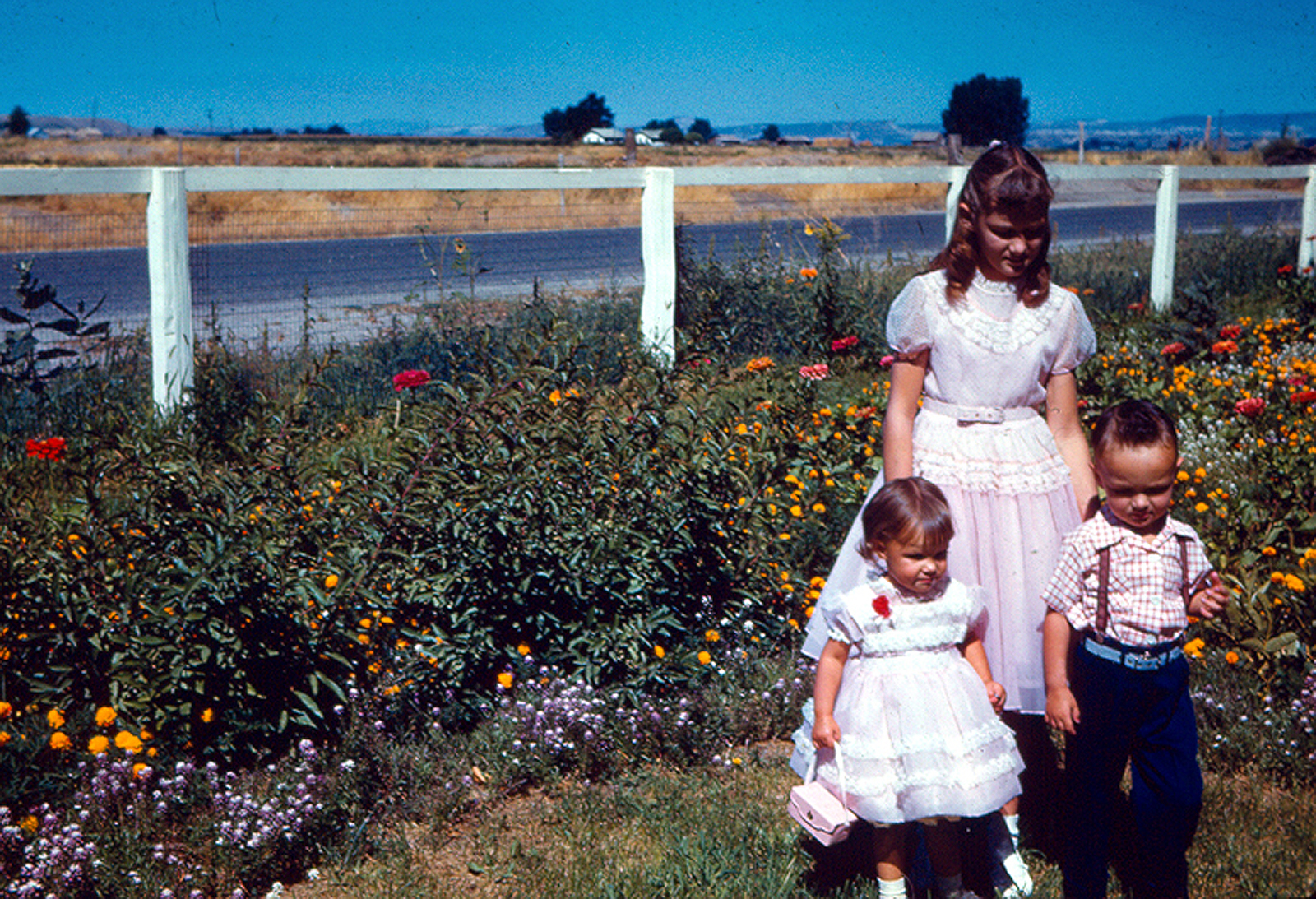 Julie, Pat and Mark in the front yard on the farm
Julie, Pat and Mark in the front yard on the farm
While we were living on the farm two children joined our family Mark Anthony was born 10 June 1956 in Caldwell and Julie Anne was born 28 August 1957 in Nampa.
In school I usually got good grades but I was bored with it. I worked for my father all summer and at nights and on Saturday when school was in session so it seemed that I was always working. I decided to quit school and work full time for my father. I quit at the end of the first semester of my sophomore year. However I decided that I would rather earn my money with my mind instead of my body so I resumed school the next year. I was able to play football and run in track the final two years of school.
I graduated from high school in 1959 a year after the other members of my class. On the afternoon of my last day of high school I and some of my friends went boating on the Snake River and later at Lake Lowell. While we were at the lake one of my friends swam to a piling about 75 yards from the shore. He swam back about to another piling about 40 yards out then he and two others swam toward the far piling. He swam about 10 yards, went under the water and never came up.
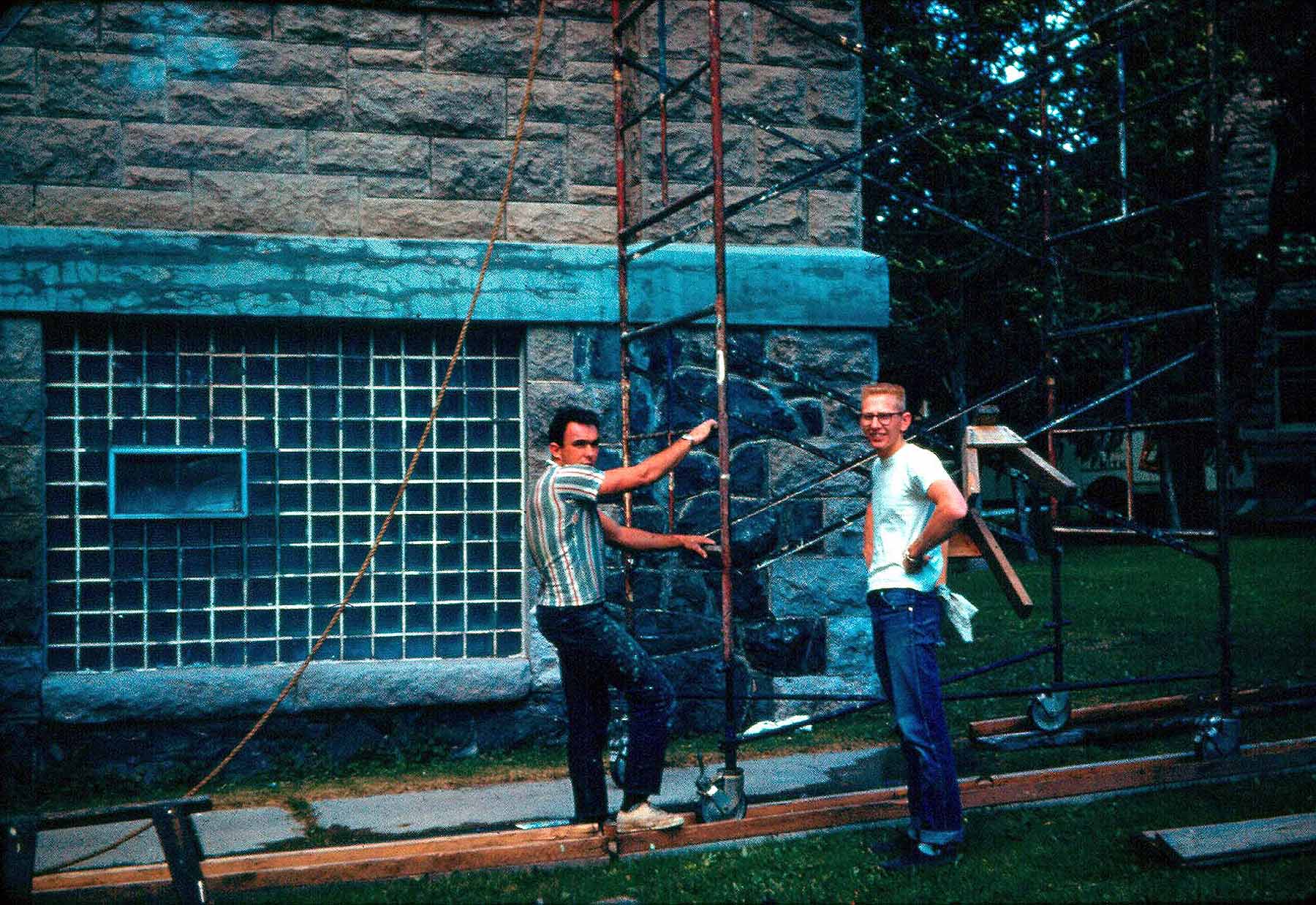 Ted Davenport and me painting under the eves of the administration building
Ted Davenport and me painting under the eves of the administration building
I made arrangements to attend Rick College in Rexburg, Idaho. That summer I moved to Rexburg and got a job working at Ricks on a painting crew. The first night in Rexburg I stayed in a motel on the southwest side of town. While I was asleep the ground began to shake and I was ejected from my bed. The shaking stopped and I went back to sleep. The next morning I learned that the shaking was caused by an earthquake in Yellowstone.
I painted the outside trim on the administration building. I had to use a high scaffold to reach the top part of the building. The scaffold was very heavy and I was supposed to have help to move it. Teddy Davenport, another man from Homedale was supposed to help me. I needed to move the scaffold around the corner of the building. I waited for Ted but he never came. I looked for him but didn't find him. I was told to move it by myself, so I did. I did well until I got it to the second position on the other side then it fell as I moved it. The crash was resounding, the effects were heard all over campus, the windows to the president's office were broken. Thankfully he was gone for the day and before he returned the windows were replaced.
I lived with five of my friends from Homedale during my first semester in the basement of a house just across West Second Street north of the old gymnasium.
 Ruth at Ricks College
Ruth at Ricks College
I first met Ruth Blacker about the middle of November. One Sunday my roommates and I were in our seats in the Kirkham Auditorium waiting for Sacrament Meeting to begin when I noticed Ruth and some of her roommates move into the seats about five rows in front of us. Later my roommates and I were invited to a dinner to an apartment that she shared with five other girls.
I enjoyed talking to her so a few days later I asked her for a date. She said yes so the next day we went duck hunting with Ted Davenport and his date. I wasn't really interested in the hunting so we didn't get any ducks. That night Ruth and I went to South Pacific at the Romance Theater.
We continued to date and by Christmas I felt that I was in love with her. After the Christmas break we resumed our courtship.
Some of of my roommates and I moved to another place the second semester. We lived in the basement of a house on the corner of East Main and Second Street East. By spring Ruth and I had decided to marry. She had earned an Associate Degree in Elementary Education and by the end of the second semester had a contract to teach in Rupert We planned that I would serve a mission and she would teach school while she waited for me.
When school was finished my parents came to Rexburg to take Ruth and me home. We traveled around to see some sites in the area. We visited the sand dunes north of Rexburg, Island Park, Big Springs, Henry's Reservoir and Warm River. We saw Quake Lake in Montana that was created by the earthquake.
We traveled to Rupert and left Ruth there. She was going to teach the fifth grade in Rupert while I was on my mission. I went home to prepare for the mission. I was interviewed by Bishop Bergeson and then he took me to Salt Lake so I could be interviewed by a General Authority. I was interviewed by Gordon B. Hinkley and when he asked where I would like to serve I told him Australia. I received my call to the Southern Australia Mission in October and was to be in the mission home in Salt Lake December 5, 1960.
I received a letter dated November 15, 1960 informing me that the Australian Government had set a quota on the number of missionaries that could serve there and that my assignment had been changed to the North British Mission. At first I was disappointed but as I thought about England I became excited to go.
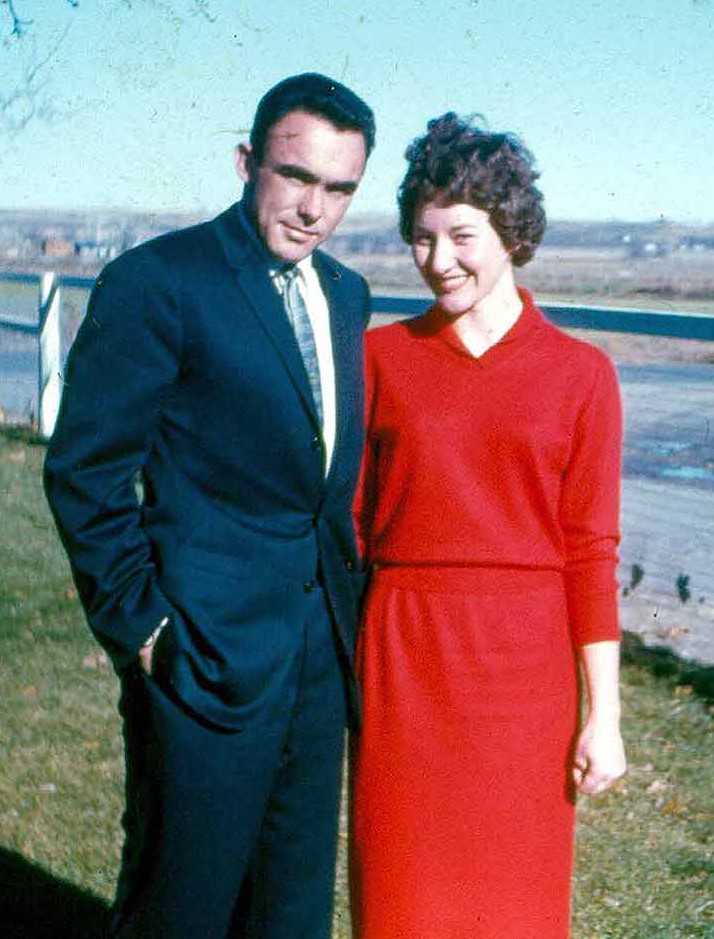 Me and Ruth at my family's farm just before I left for my mission
Me and Ruth at my family's farm just before I left for my mission
Ruth came to my farewell on November 27, 1960. My parents also had an early birthday party for me. I rode the bus from Caldwell to Salt Lake and got to the mission home late about 6:30 pm on Sunday, December 4. It was snowing as I arrived. There were 12 of us going to the North British Mission and almost all of us had been transferred from the Southern Australian Mission.
My mission training began Monday December 4th and lasted until Tuesday, December 13th. My companion in the Mission Home was Elder Paul Byington. I had known him slightly at Ricks. On Wednesday, December 7, Elder LeGrande Richards set me apart as a missionary. I was endowed December 9th in the Salt Lake Temple. My mother and her brother, Uncle Archie spent December 12th with with me. I and the other Elders bound for the North British left Salt Lake on a Western Airlines DC7 at 1:30 am on December 13th. We arrived in Denver at 3:30 am local time, changed planes and went from there to Chicago and then to New York, arriving there 3:55 pm local time.
When the plane was ready to land at Idlewild Airport in New York it had to circle out over the bay. There was a storm and it was cold and very windy. As I looked down on the ocean waves I could see that I would drown quickly if I fell into it. The wind caused the plane to feel "turbulence", a new term to me. I had flown in a small plane over the mountains of Idaho when I worked for the forest service and the rides were quite bumpy. However this was different, somehow seeing a mountain below was less intimidating than all of that water.
However we landed safely and waited for our flight on BOAC to London. We were supposed to leave at 8:00 pm for Manchester but the flight was canceled because of bad weather and our schedule was changed to leave at 6:00 am the next morning December 14th for London then from there to Manchester. However the plane going to London needed a new engine installed so we had to stay in New York another day.
BOAC lodged us in a hotel and we spent Wednesday the 14th seeing some of New York. We finally left for London at 1:00 am on the 15th. We couldn't land in London because of bad weather so we continued on to Manchester. However the weather in Manchester was bad so we landed at Prestwick airport near Glasgow, Scotland. In Prestwick we waited until the weather in Manchester cleared and then flew back to Manchester in an old, somewhat shabby, very small, propeller driven plane. Because of the weather we had to fly very low so I saw Scotland and Northern England from just above the tree tops, well maybe a little higher.
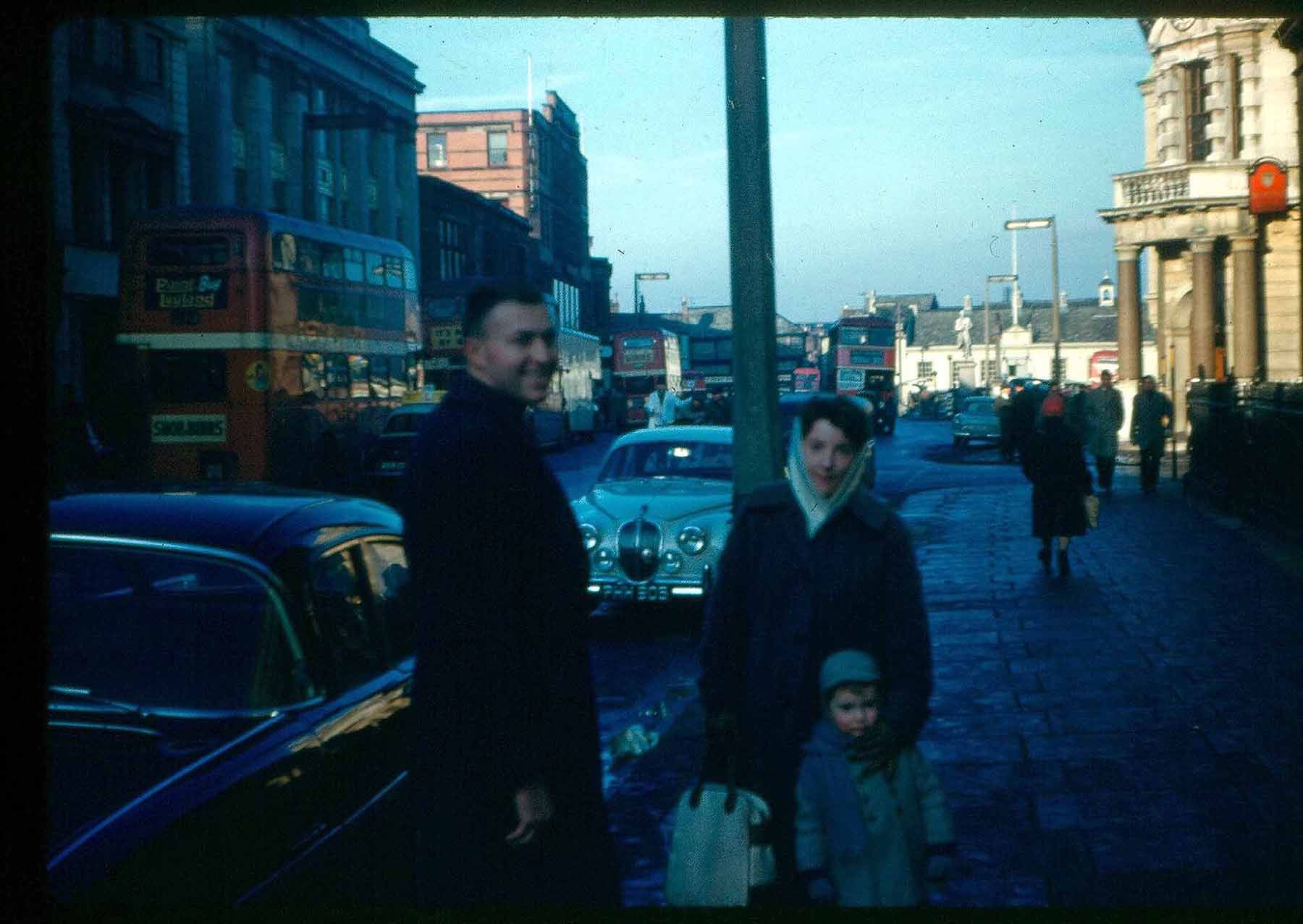 My companion with the branch president's wife and son in Carlisle.
My companion with the branch president's wife and son in Carlisle.
There were two missions in the British Isles, the British and the North British. The North British Mission home was located at 118 Park Road, Hale Cheshire. My mission president was Bernard Brockbank. I stayed there for one night and the next morning we took a train to Retford then a chartered bus to London to attend the temple. When we got back to Manchester I traveled by train to my first area in Carlisle, Cumbria on December 19th. My mission was divided into districts and Carlisle was in the Lake District which had just been opened. My companion was Elder George Mote from Grants Pass, Oregon. We lived at 80 Warnell Drive in Carlisle.
I had to learn a lot of new things besides missionary work. It was hard to understand the people even though they spoke English. The climate was wet and even though the countryside was beautiful the wetness caused many of the buildings to smell musty. The money system of course was based on pence (penny) shillings (12 pence) and pounds (₤). The exchange rate was $2.80 for each pound.
The change in altitude from Idaho to England effected me. For the first few days I was very tired. Gradually I got used the elevation and was able to breath better. We tracted a lot but without much luck. We had a small struggling branch of the church there. The branch president and his wife were good to us.
About this time the missions were divided in the British, Central British, North British and Scottish-Irish. I was in the area that remained a part of the North British. President Brockbank moved to the Scottish-Irish mission and our new president was Grant Thorn from Springville, Utah.
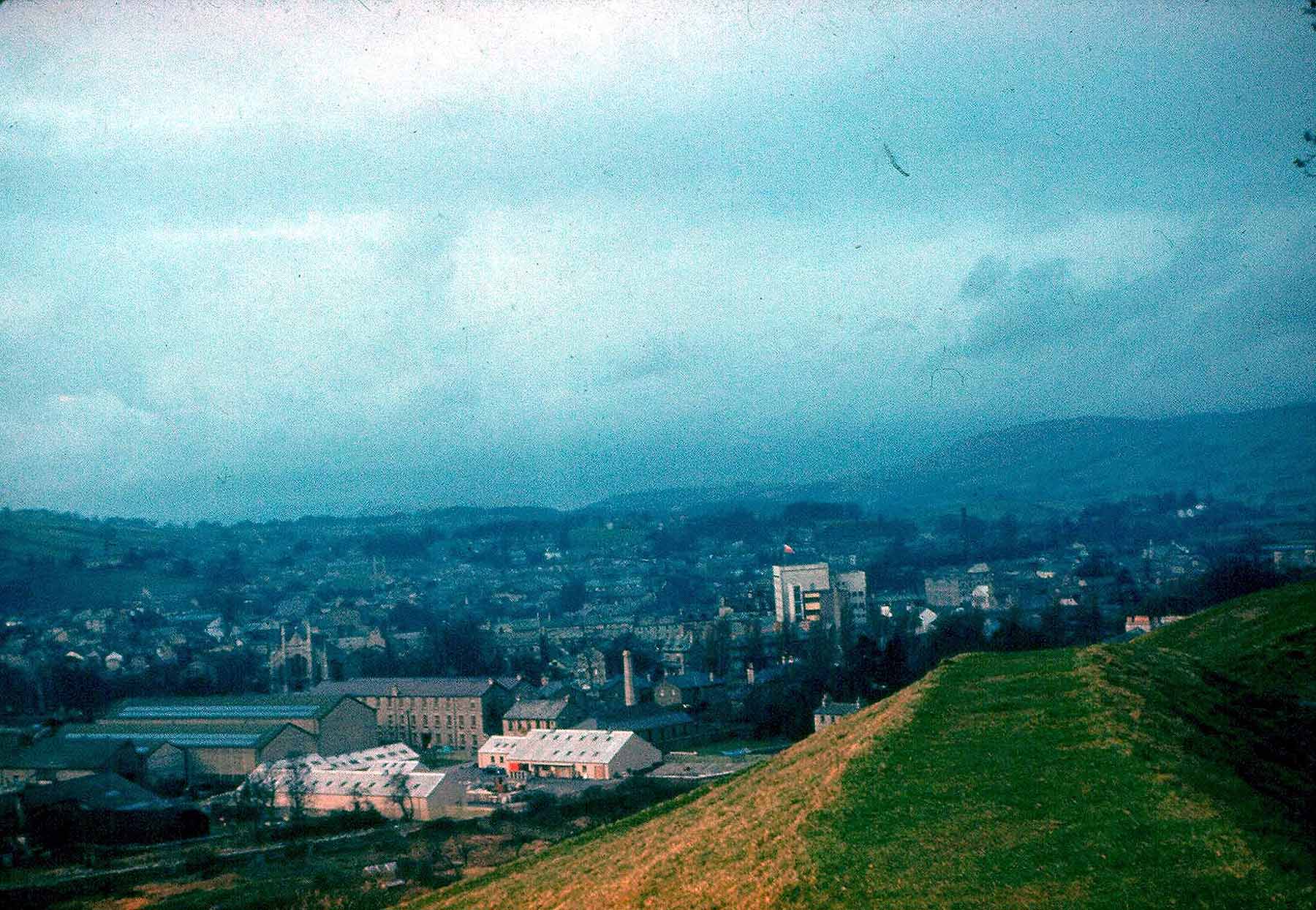 Kendal from the moor
Kendal from the moor
There had been no missionaries in Carlisle for a long time because the people weren't very receptive. Elder Mote and I didn't find anyone to teach so in January 1961 we left Carlisle. Elder Mote went to Barrow-in-Furness with another Elder. My new area was Kendal. I arrived there on January 30th. My companion was Elder William Callister and we were the first missionaries there for many years.
We had a hard time finding digs (a place to stay) in Kendal so we had to stay in a hotel for a few days. Kendal was a small, pretty town in the heart of the Lake District but it was hard doing missionary work there. We had rocks thrown at us and faced many rejections. We were there for only a month then we were both transferred.
I was transferred to 12 Arnside Road, Southport a resort town on the west coast. My new companion was Elder Wilford Daynes from Salt Lake City. The work in Southport went better than in Carlisle or Kendal. We baptized four people while I was there. I was in Southport from March 5th to April 5th then I was transferred to the mission home to work in the publications department with Elder Monte Brough. We spent a lot of time traveling around the mission creating a district mission program using local people as missionaries. I had the opportunity to speak in most of the branches in the mission.
The missions in the UK and France were grouped together and called the Western European Missions. N. Eldon Tanner was the president of the group and was based in London. He came to tour our mission. Elder Brough and I were assigned to go with him and President Thorn. We went to every area in the mission and met with each group of missionaries. I served in the mission home until May 31, 1961.
 Buses in front of our digs in South Shields
Buses in front of our digs in South Shields
Ruth turned 21 on her birthday in May and her Bishop asked her to prepare for a mission. She was called to the Scottish-Irish mission just north of where I was. She arrived in Scotland 27 June 1961.
At the end of May I was transferred to South Shields County Durham in the Newcastle District on the east coast. My digs were at 47 Westoe Road. My new companion was Elder Gerald Guymon from Provo. Our mission had a girls softball program. We taught the girls in our branch how to play. Each district held a tournament. Our branch had a large number of active girls so we had a good team. They won the district tournament and went to Manchester for the mission tournament.
In August 1961 while I was working in South Shields our district used a personal day and traveled to Scotland. Our Supervisor Elder, Elder Heaton, had received special permission from the mission president for us to make the trip. Each district had a van to transport missionaries and church members in. Our whole district rode in the van. We started very early in the morning and traveled a long time, stopping along the way to take pictures.
 A sign on a door in Stirling Castle
A sign on a door in Stirling Castle
We toured Stirling Castle and the area around it. We rode in very small boats on Loch Lomond.
From Loch Lomond we went east toward Edinburgh looking at sites along the way. That evening in Edinburgh we went to the Military Tattoo, which is a concert performed by various military musical groups. All of the missionaries in the Scottish Mission were there that night. Ruth and I had arranged that we would meet at the castle gate after the Tattoo was over. Elder Guymon and I stood at the gate and waited for Ruth and her companion, Sister Hyde. When they came out I gave her a 35mm camera I had bought for her. We talked for a few minutes then separated to go to our areas. Elder Guymon and I didn't get back in South Shields until early the next morning.
In September, 1961 I was transferred to 57 Southgrove Road, Sheffield. My companion was Elder Michael Bridge. On October 17, 1961 I was called to be a Traveling Elder and worked from the mission home.
My family went on their usual hunting trip in 1961 and took the horses with them. While they were there Gypsy got away from them and joined the other horses at the McKenzie ranch. She stayed there all winter and my parents caught her the next spring. They sold her shortly after they found her.
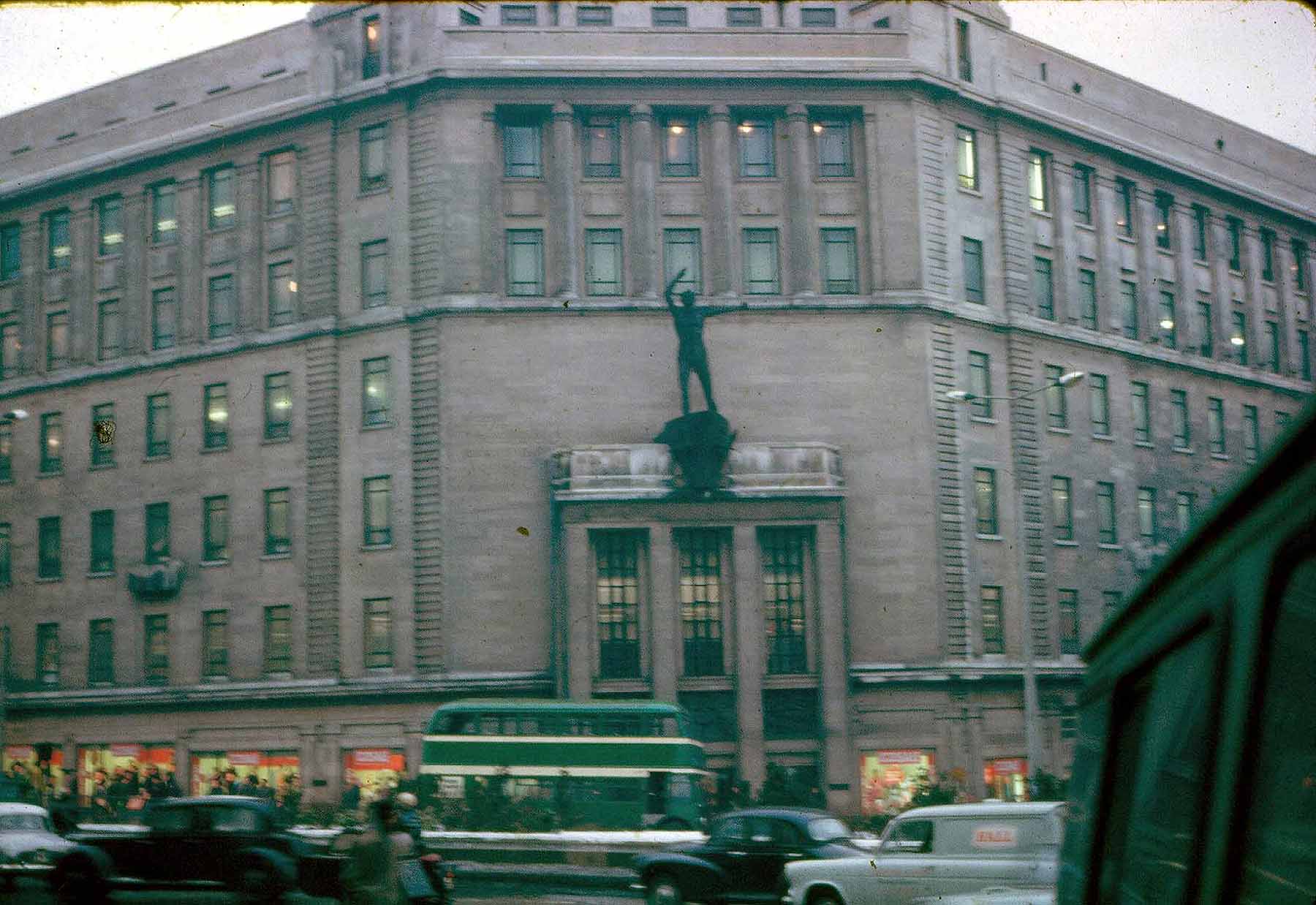 Liverpool
Liverpool
On November 13, 1961 I was called to be the Supervising Elder of the Liverpool District with Elder Hansen as my companion. He was a great missionary. Liverpool was a large dirty, port city on the Mersey and is full of Liverpudlians. I enjoyed the exciting pulse of the place. We had a nice small branch there. My companion and I taught some boys to place American Football. The church owned an old building that we met in. It had a room with a water tub that was used for a baptismal font.
On January 17, 1962 I was called to be the Supervising Elder of the Middlesbrough District. I was to drive the district van there and pick up my new companion Elder Cottrell on the way. We arrived in Middlesbrough late at night. It so late that we slept in the van until morning, when we could look for our digs. We lived with a couple and their daughter Jackie at 87 Oxford Road. They had four other boarders and we all ate our meals in a large room at the front of the ground floor. Our room was across the hall from the dining room.
Sometime in June Elder Cottrell was transferred and Elder Larry Zaugg became my companion. My time with Elder Zaugg was probably the most productive of my mission. We worked well together and taught some great families. I was in Middlesbrough from February to October and had two very good companions.
Sometime in the middle of 1962 the four British missions were divided forming eight missions. My area was in the newly named Northeast British Mission. President Thorn was still my mission president but the mission home was now at "Rossett Green", Rossett Green Lane, Harrogate, Yorkshire.
On October 20, 1962 I was called to be a Zone Counselor and moved to 41 Stanley Road, Wakefield. My companion was Elder Young.
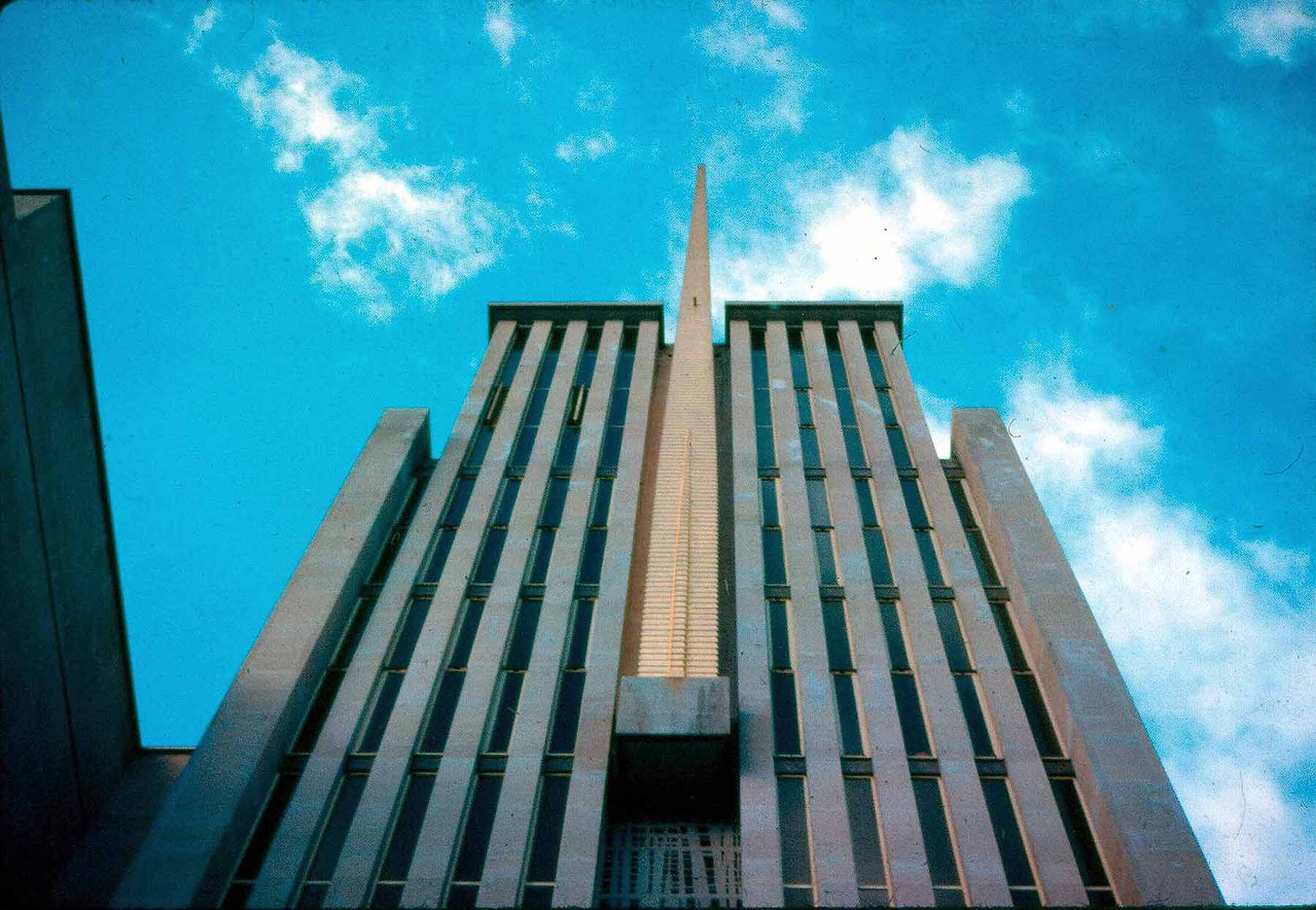 The front of the Hyde Park chapel
The front of the Hyde Park chapel
President Tanner called a conference for all mission leaders of the Western European Missions in London for October 30 and 31 at the Hyde Park Chapel in London. I was there with my group of supervising elders and Ruth was there because she had been called as a traveling sister. She and her companion were the only Sisters at the conference.
She and I sat together during the conference. Of course our companions sat next to us and the supervising elders from my zone sat all around us to be sure we didn't break any mission rules. The night of the 30th I and my group took her and her companion to a restaurant. We returned to our areas on November 1st.
I was released December 15, 1962. I traveled by train from the mission home in Harrogate to London and spent the night in a hotel. I was awake most of the night watching the crowd and listening to the noises of the busy street below my window. The next morning I took a taxi to Heathrow where I caught a plane for Chicago. The plane was late arriving in Chicago and my schedule had to be changed. Instead of flying to Salt Lake then to Boise I went to Denver then to Boise. I arrived in Boise earlier than I was expected so I had to call my family and ask them to come and get me.
It was good to be back with my family. Some things had changed. They had sold the farm and were living on a small place south of Homedale. Gary was married and living in his own home. They also sold the horses because they didn't have room to keep them. After Christmas I worked for my father in the packing shed.
Ruth got home from Scotland just before Christmas. I went to see her in January. We continued our courtship and began to plan our marriage.
I worked for a farmer in Adrian, Oregon and for my father to earn money for school. Ruth and I corresponded almost daily and she came and stayed with us for a few days. She was substituting in an elementary school to earn money for college. We visited each other while we prepared for school in the fall. The fall of 1963 I enrolled in the College of Idaho in Caldwell.
We planned to be married February 28, 1964 in the Idaho Falls temple. The great day finally arrived. We were married and moved into a small apartment in Homedale so I could continue school.